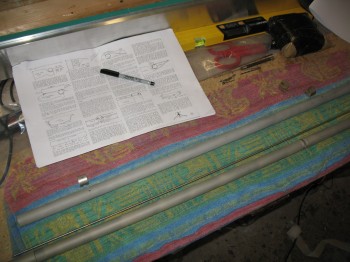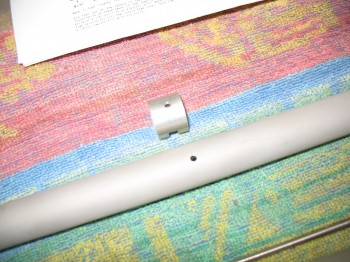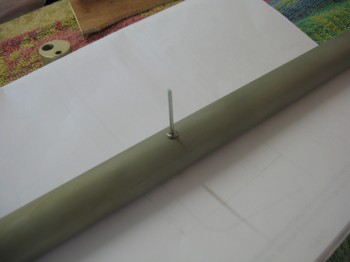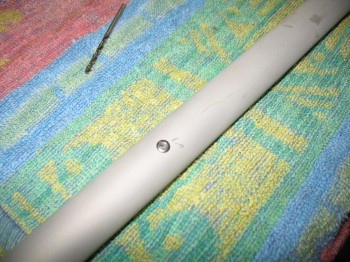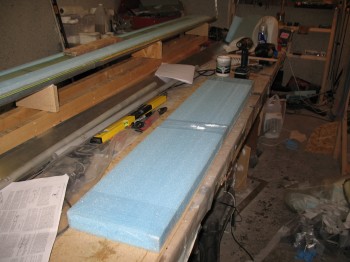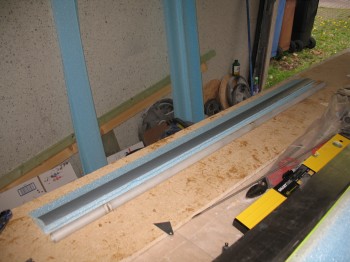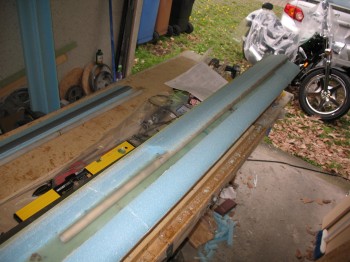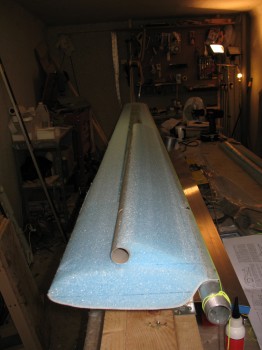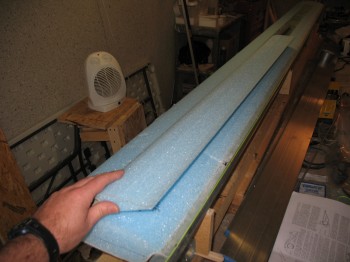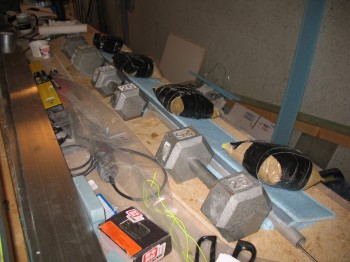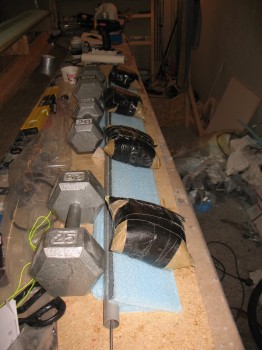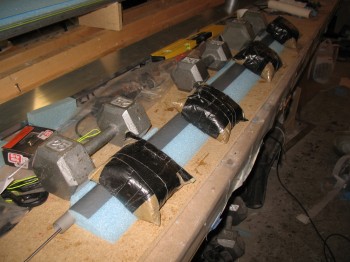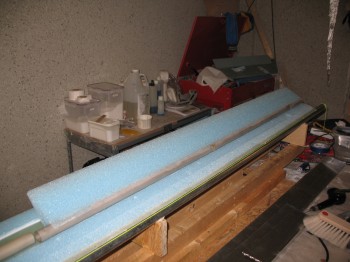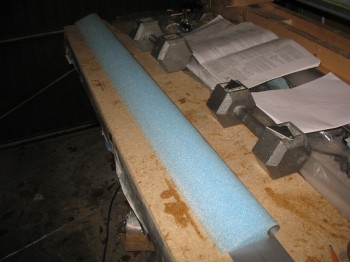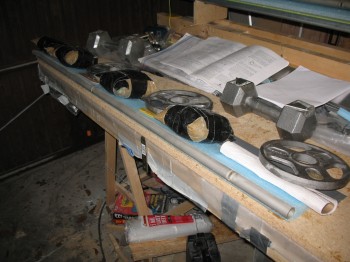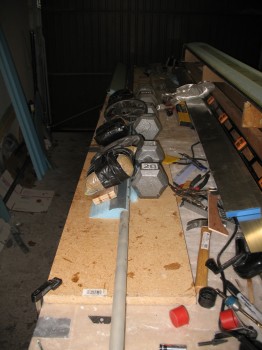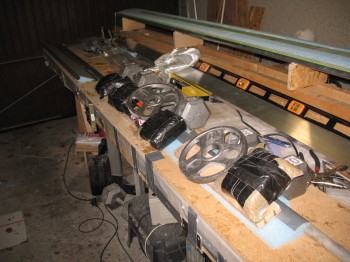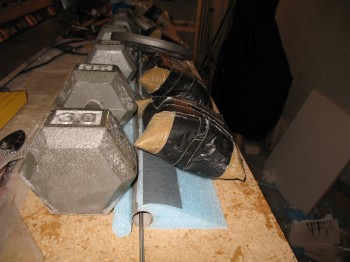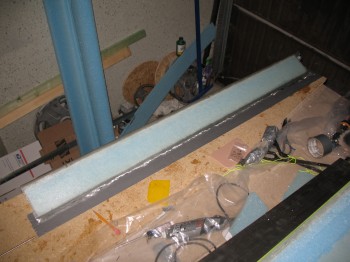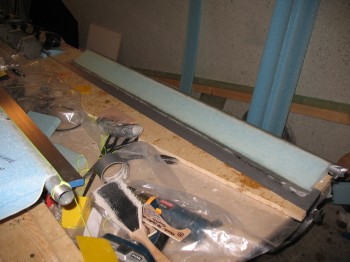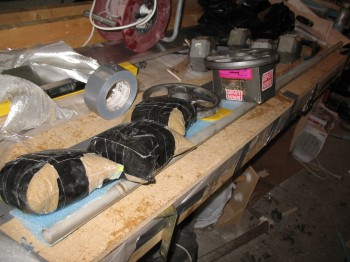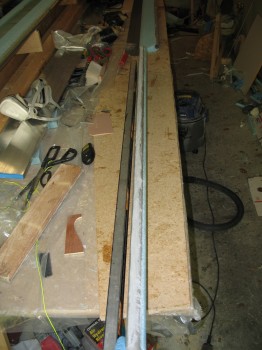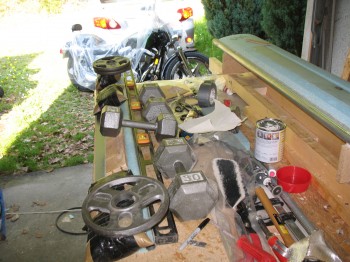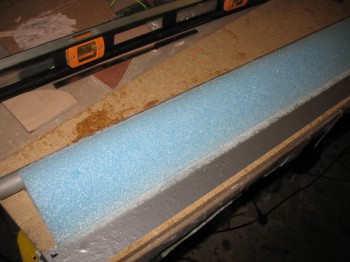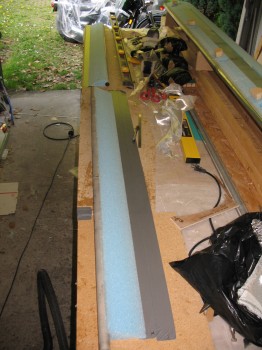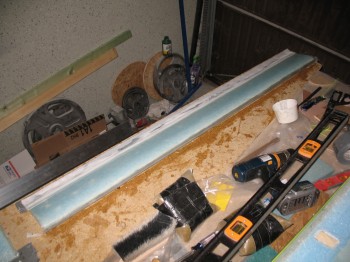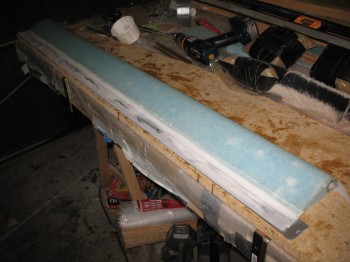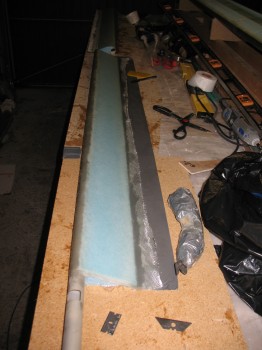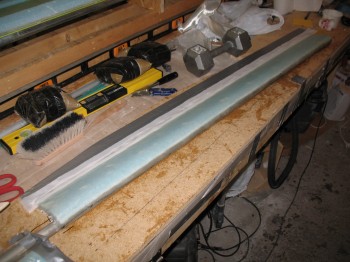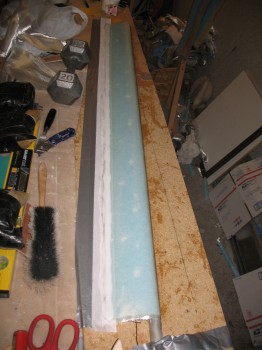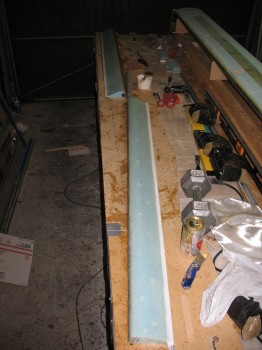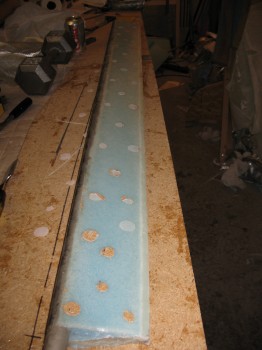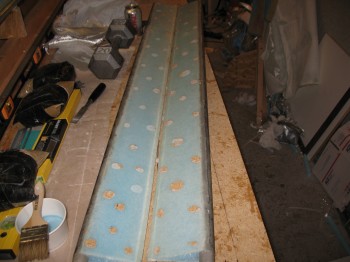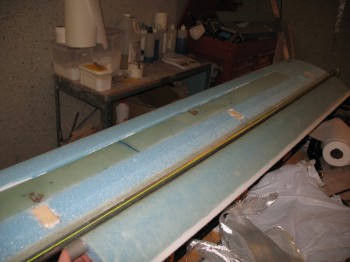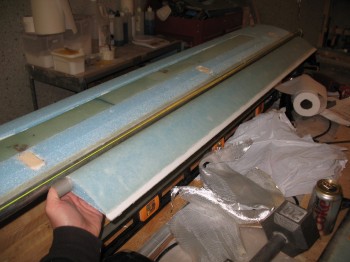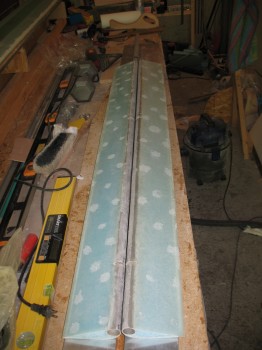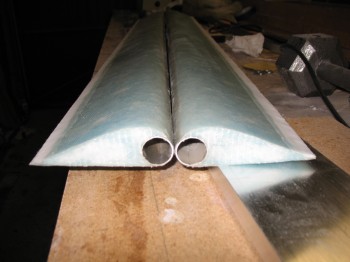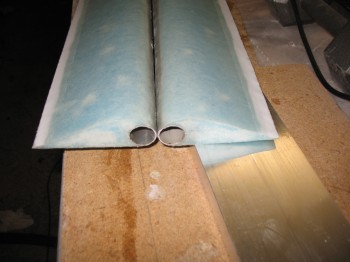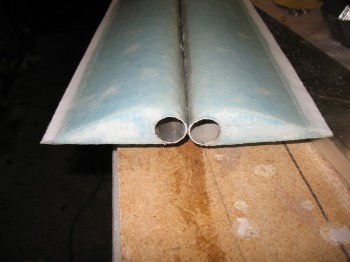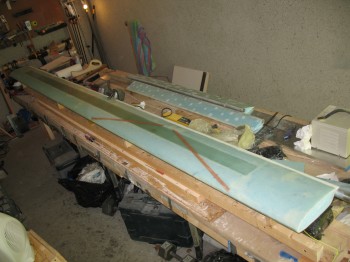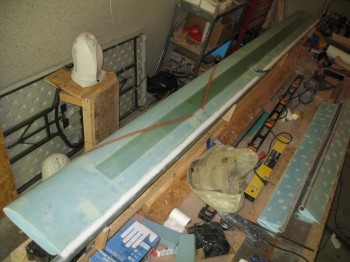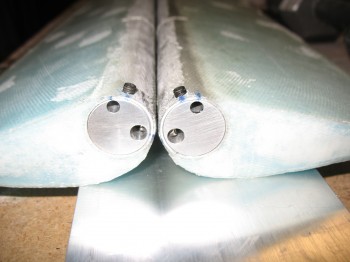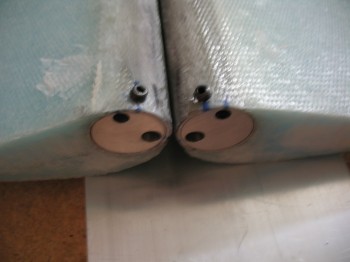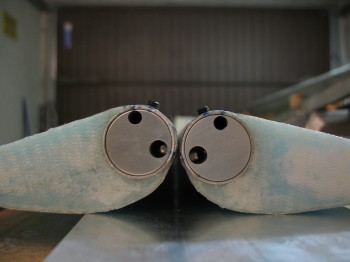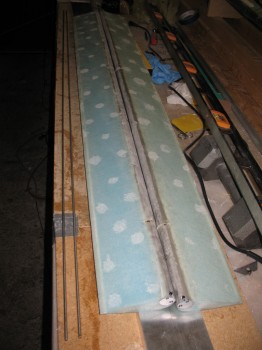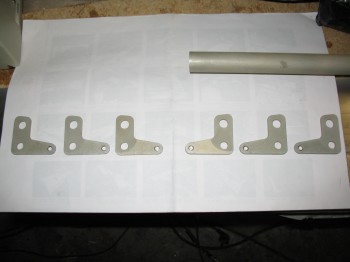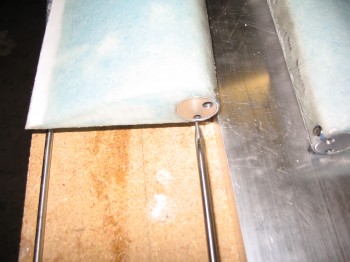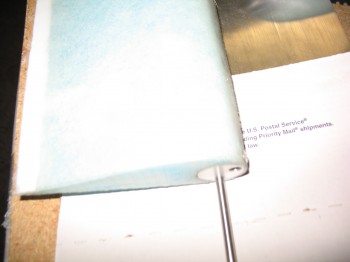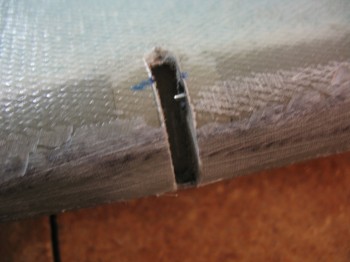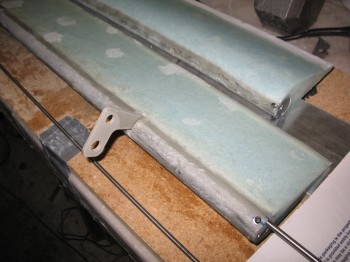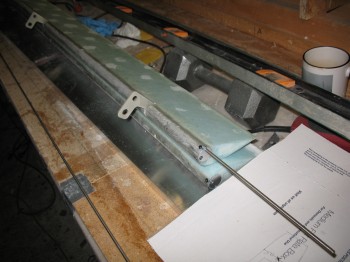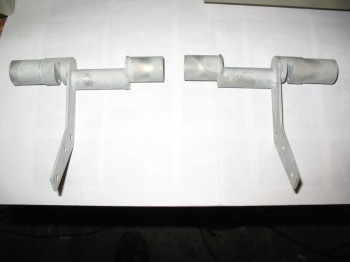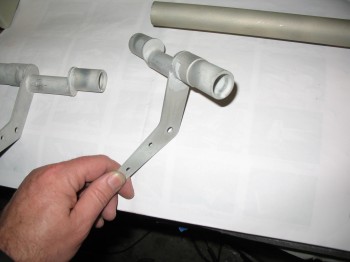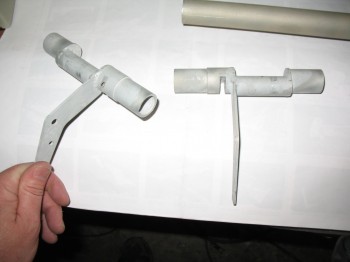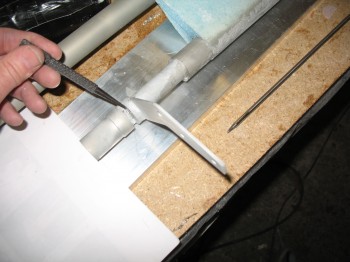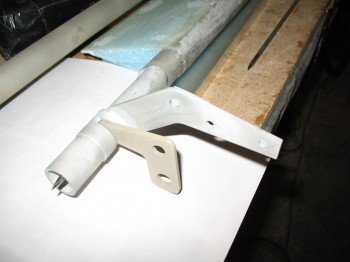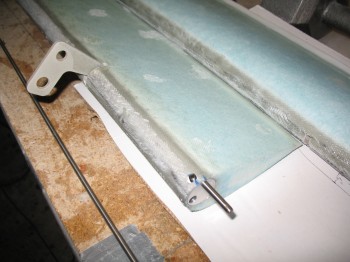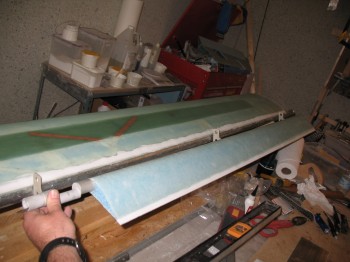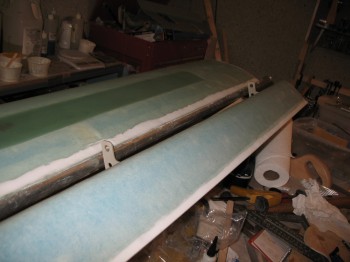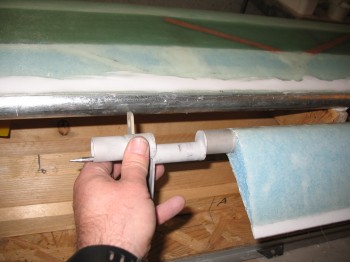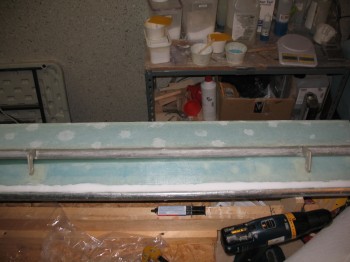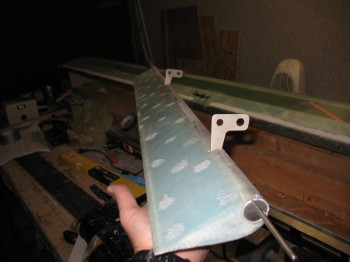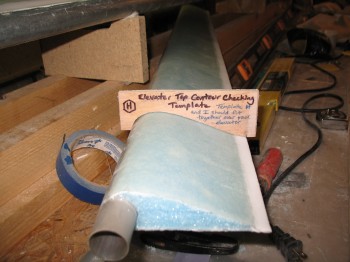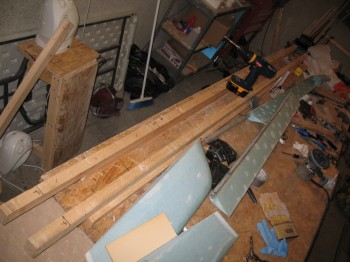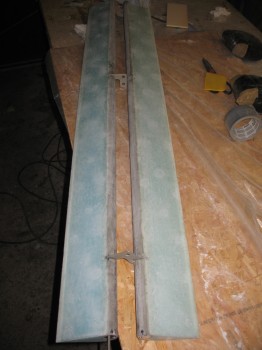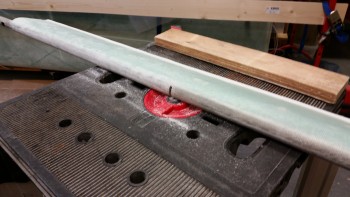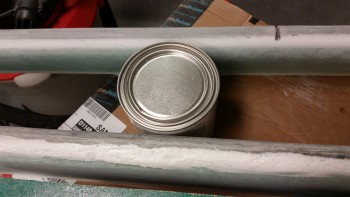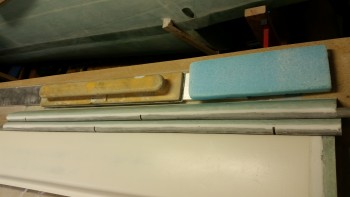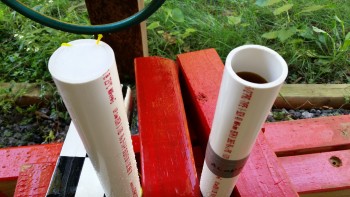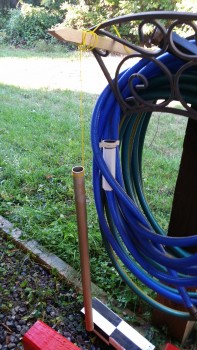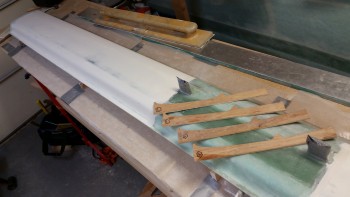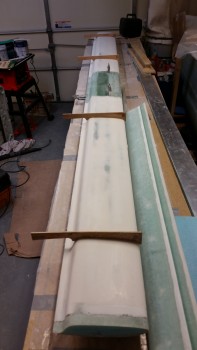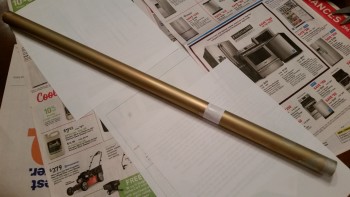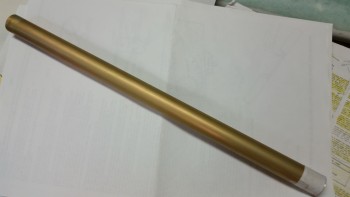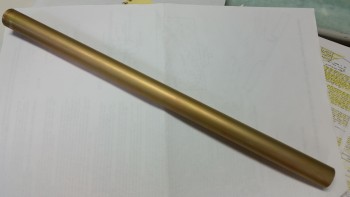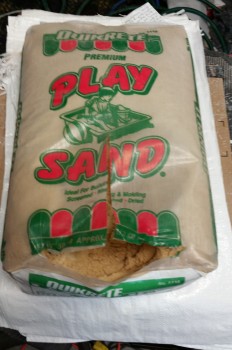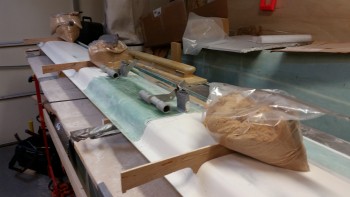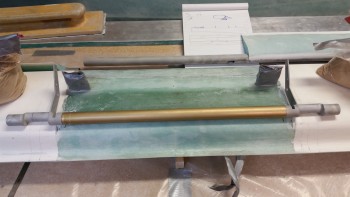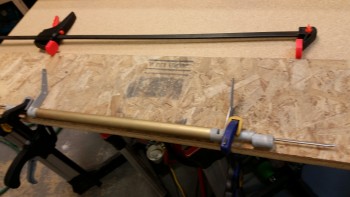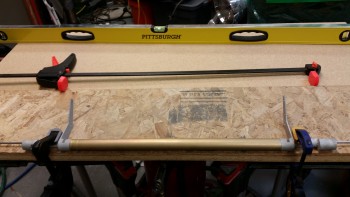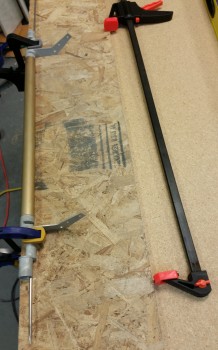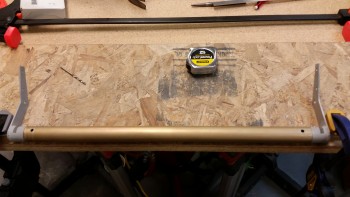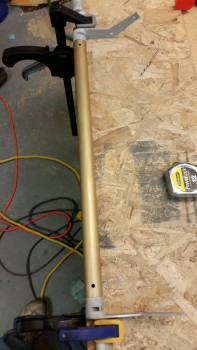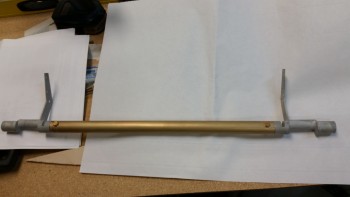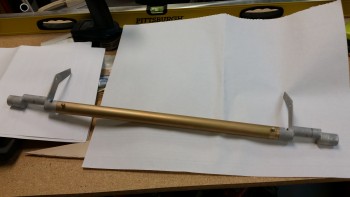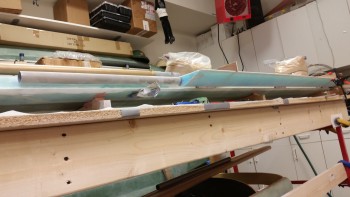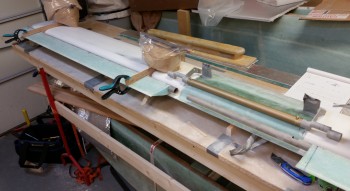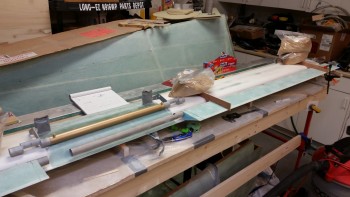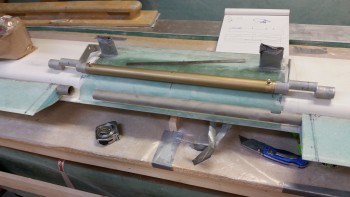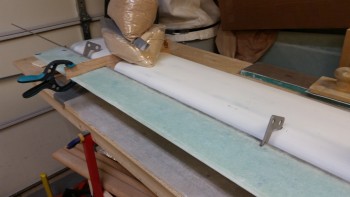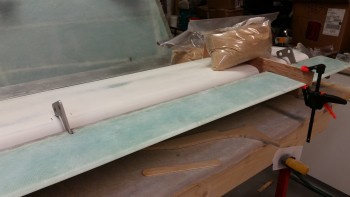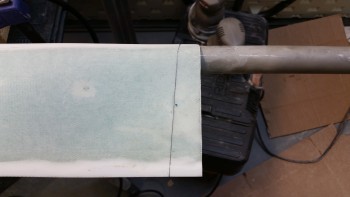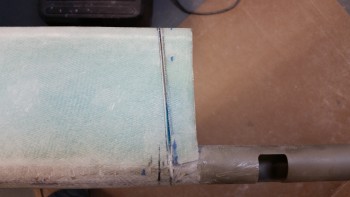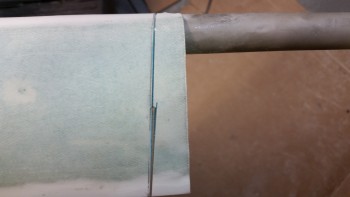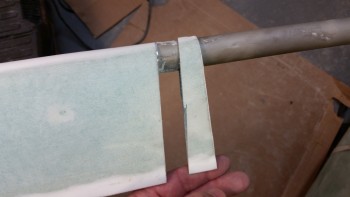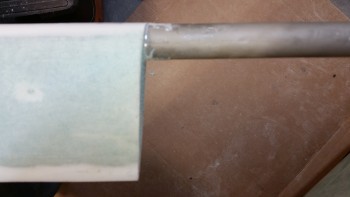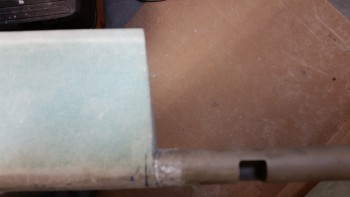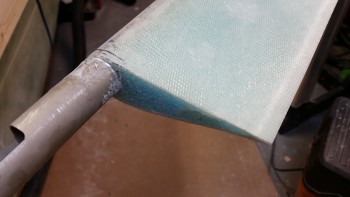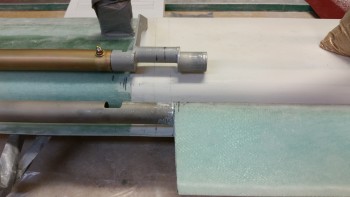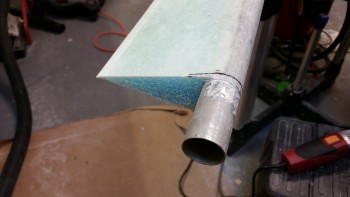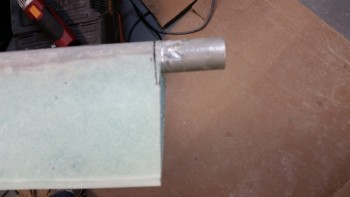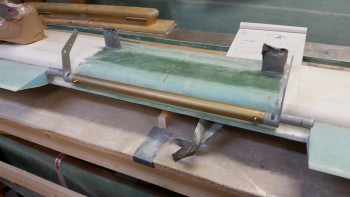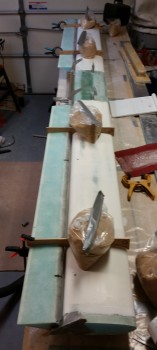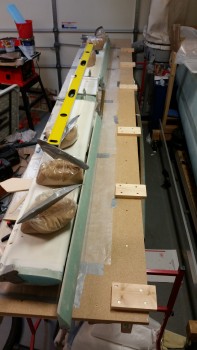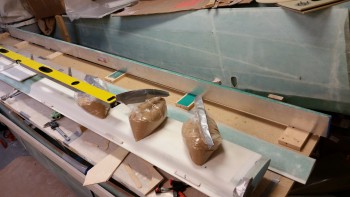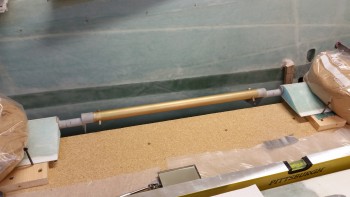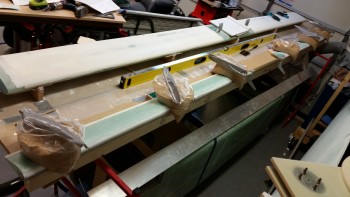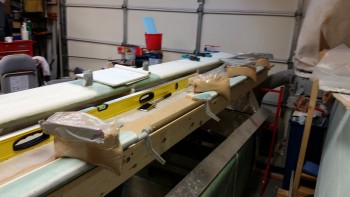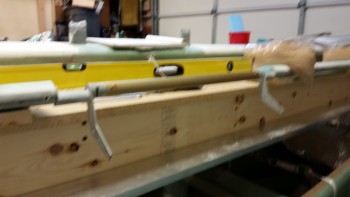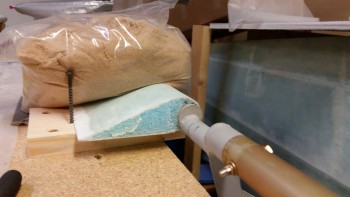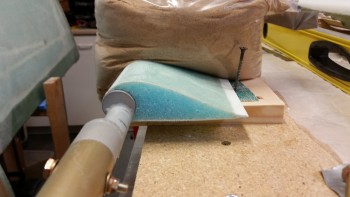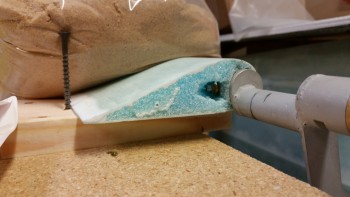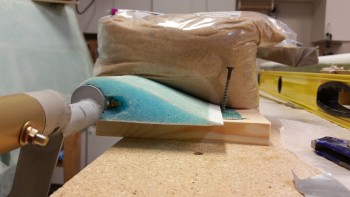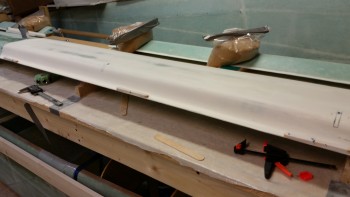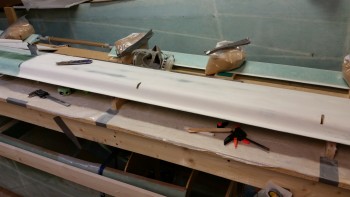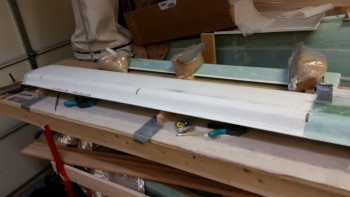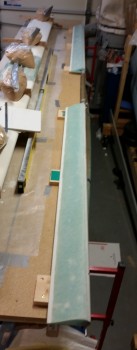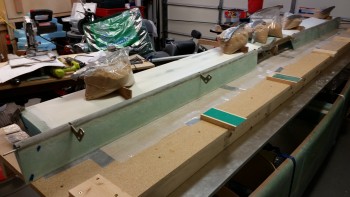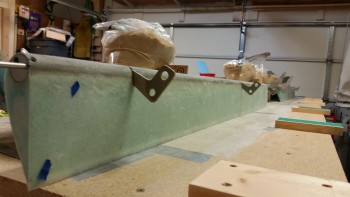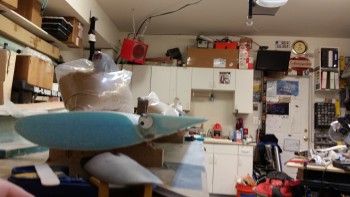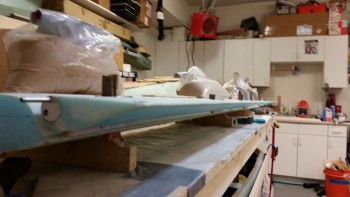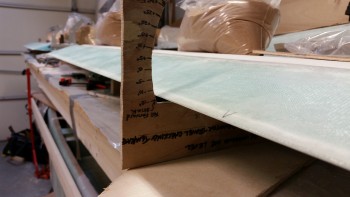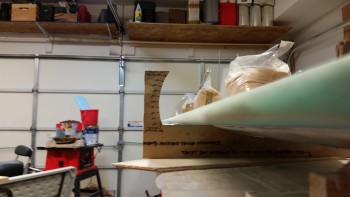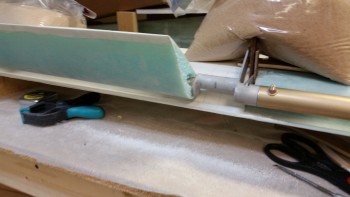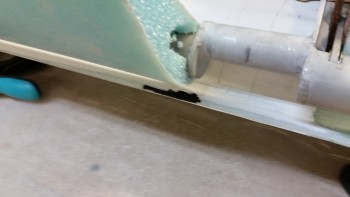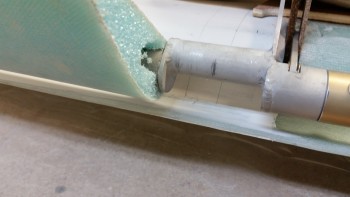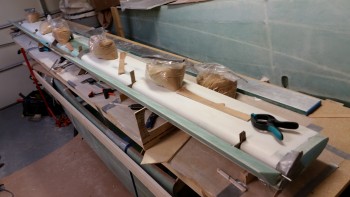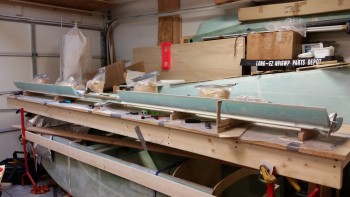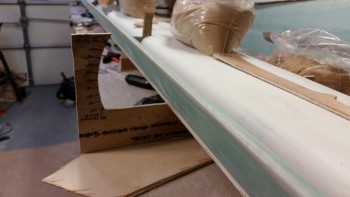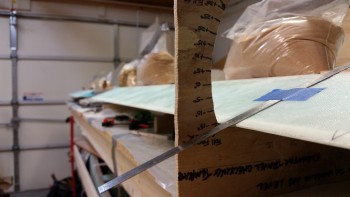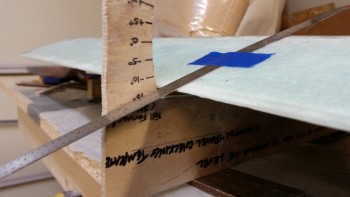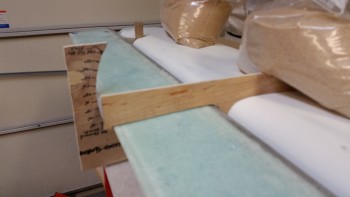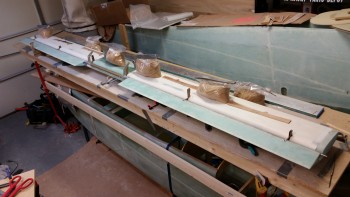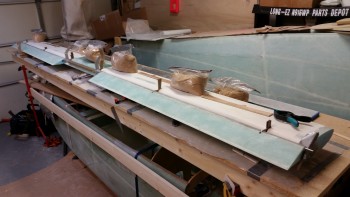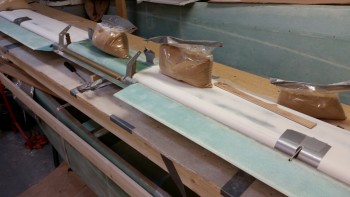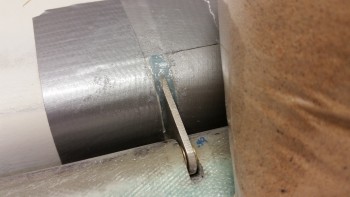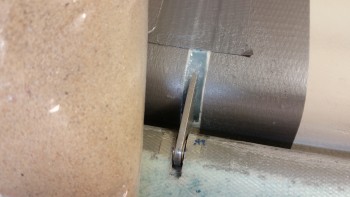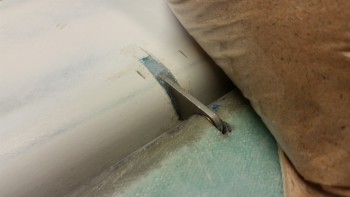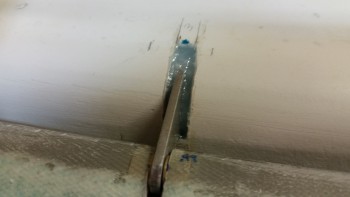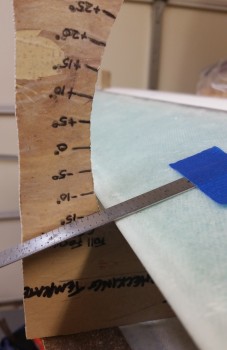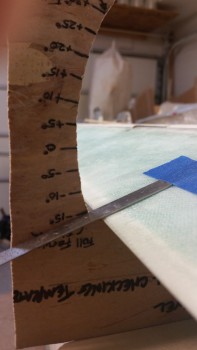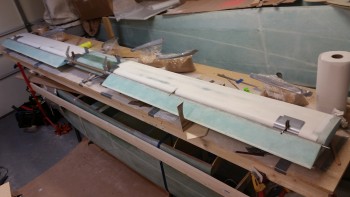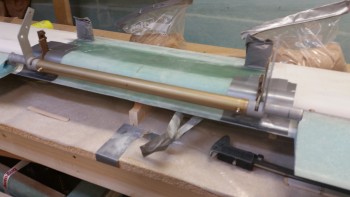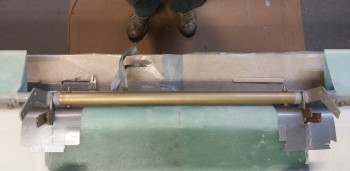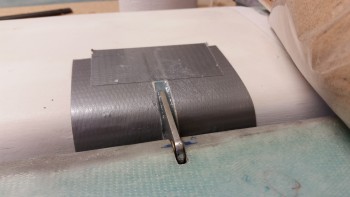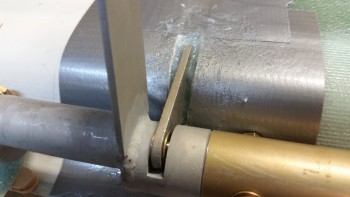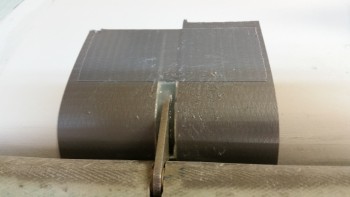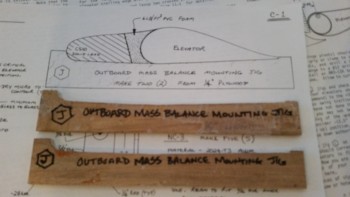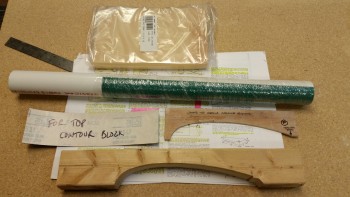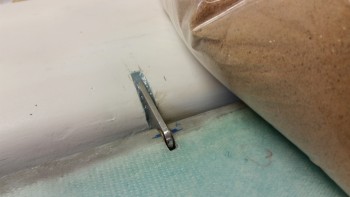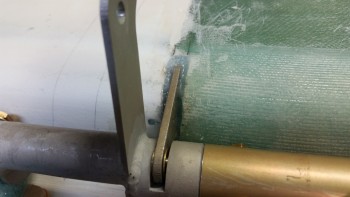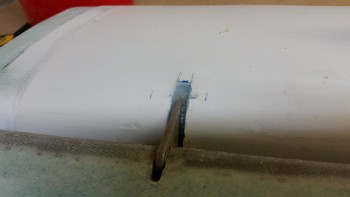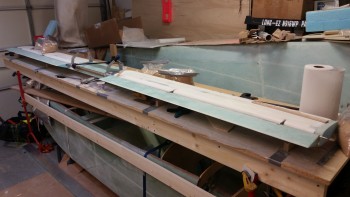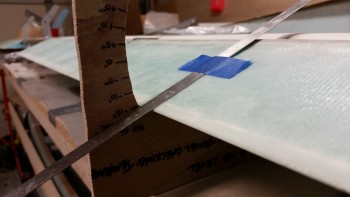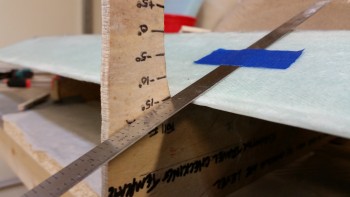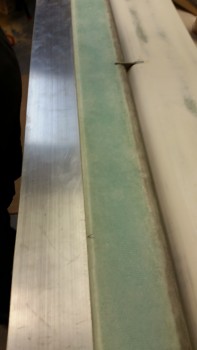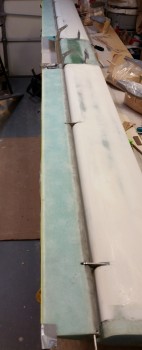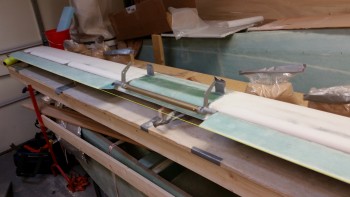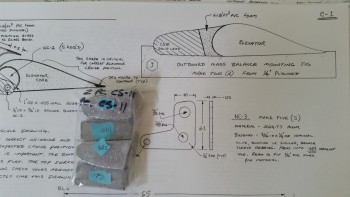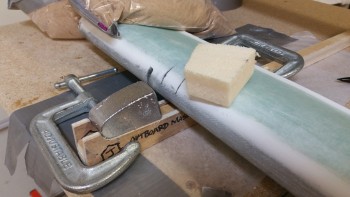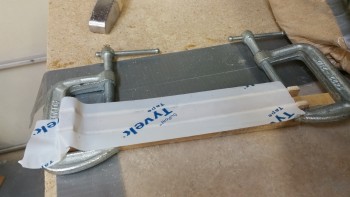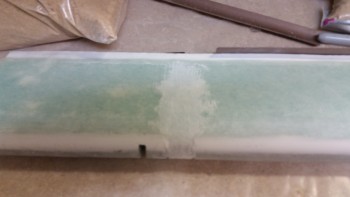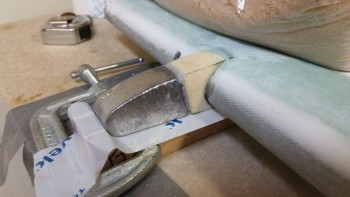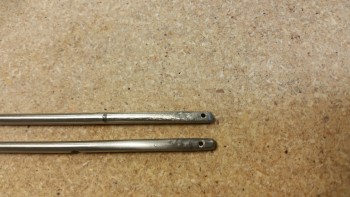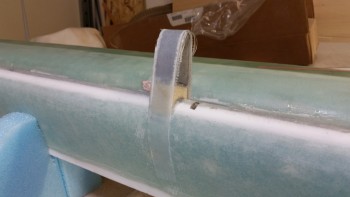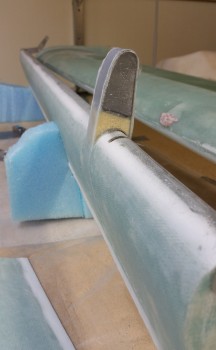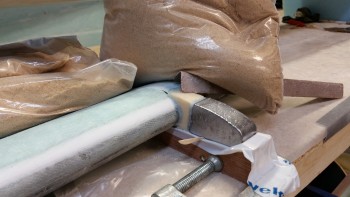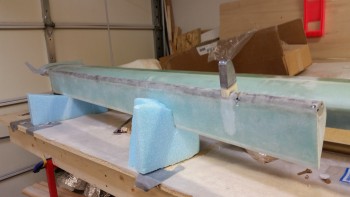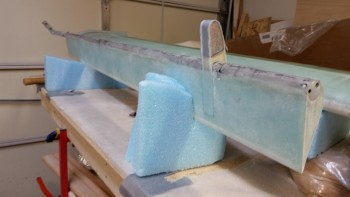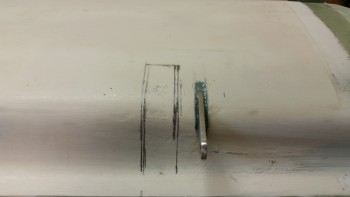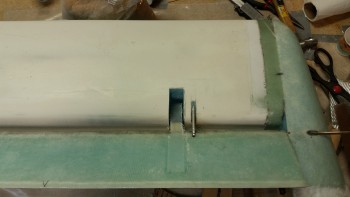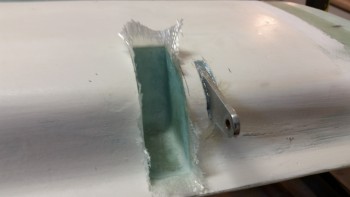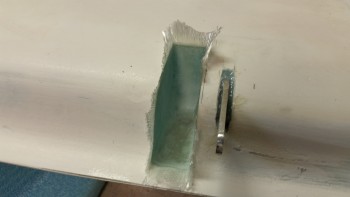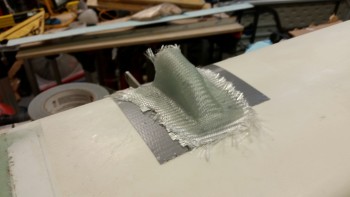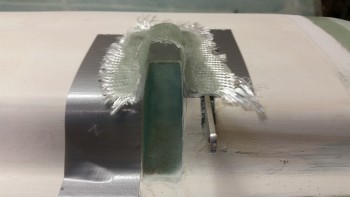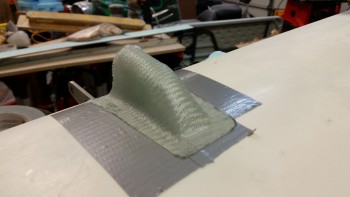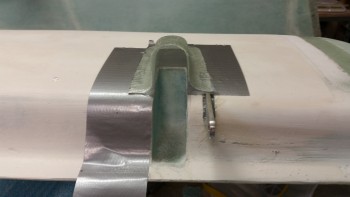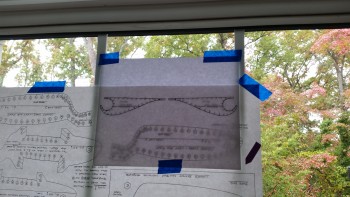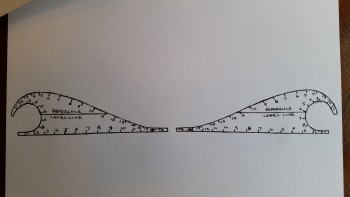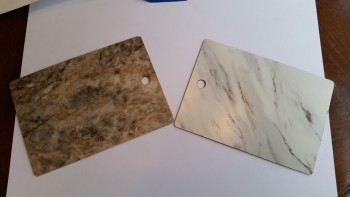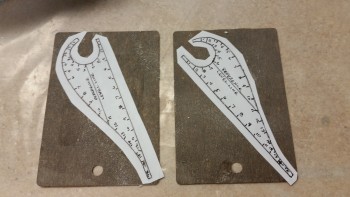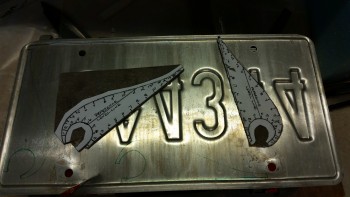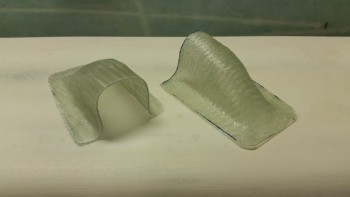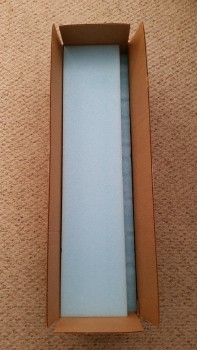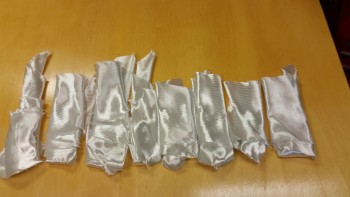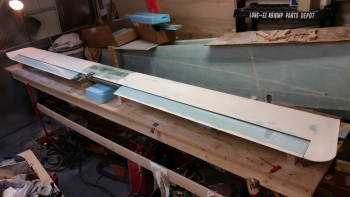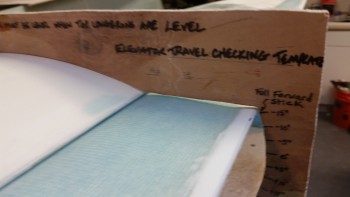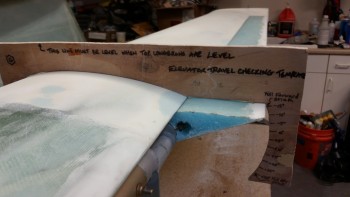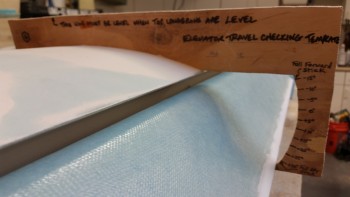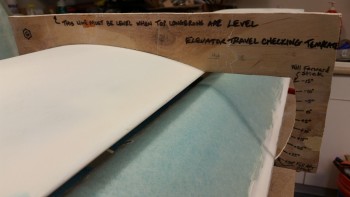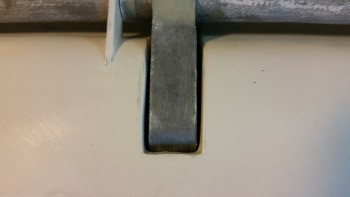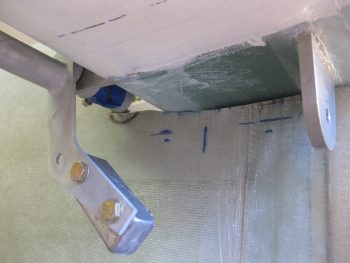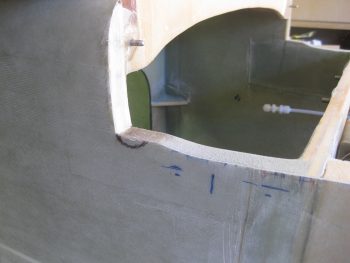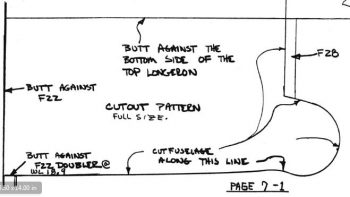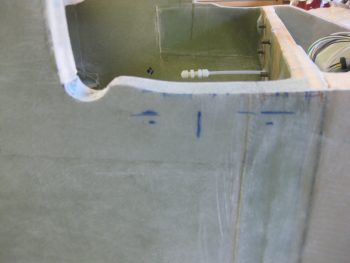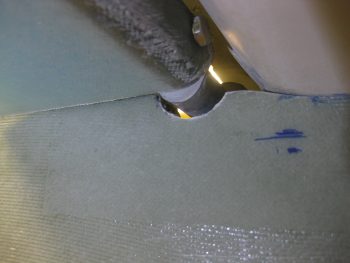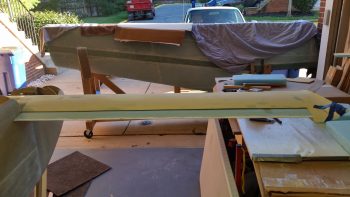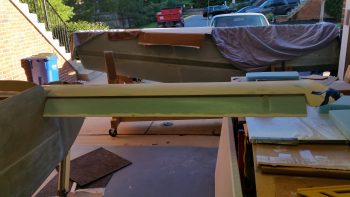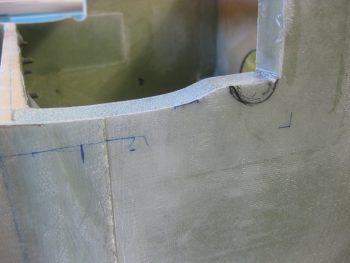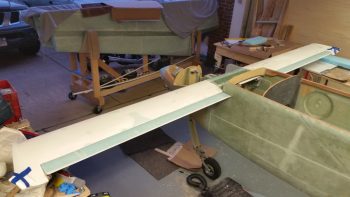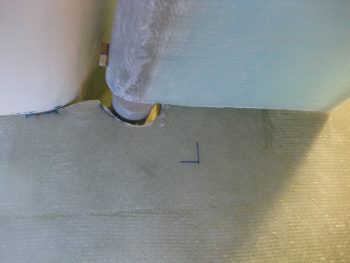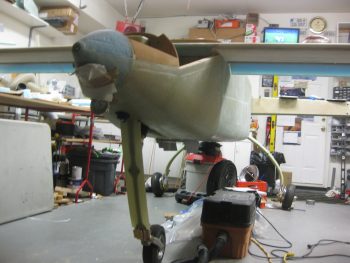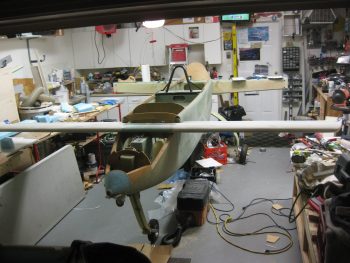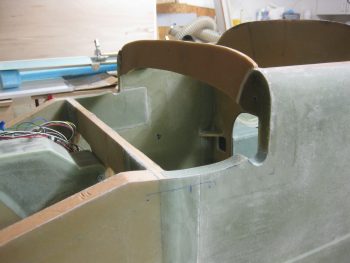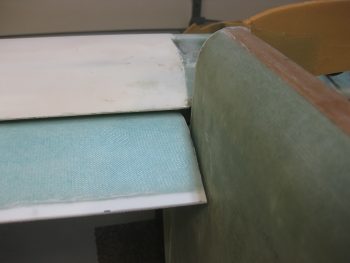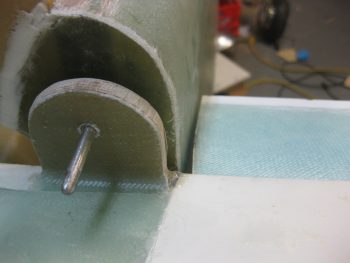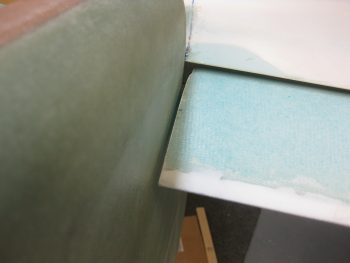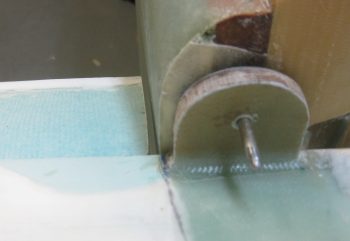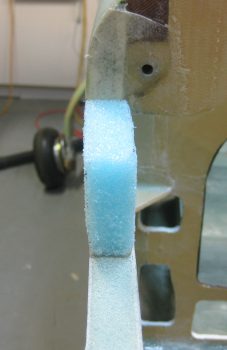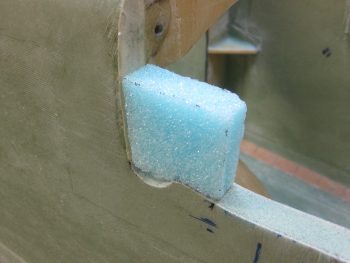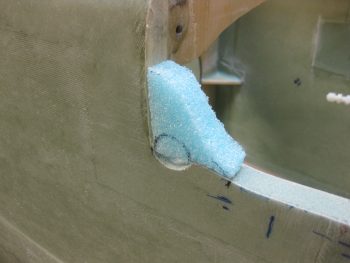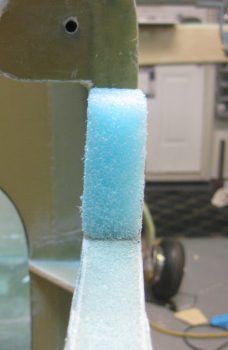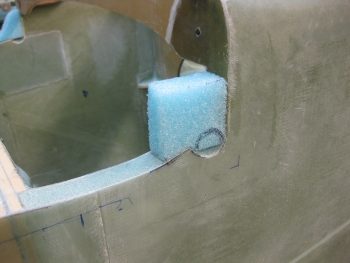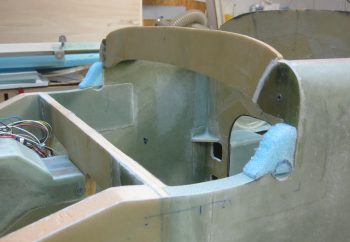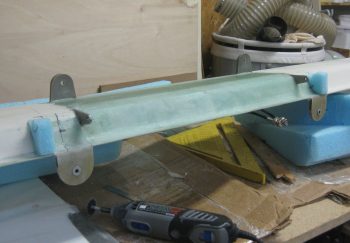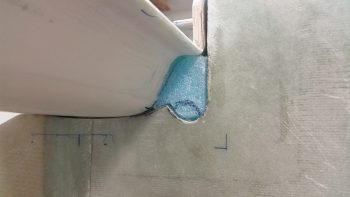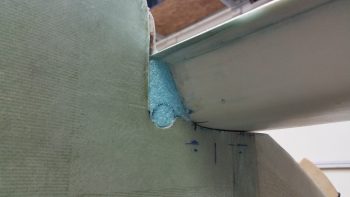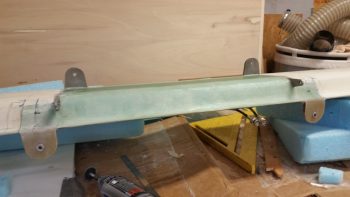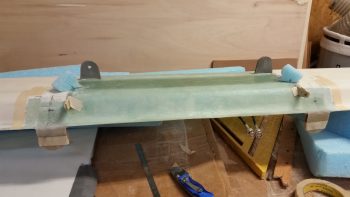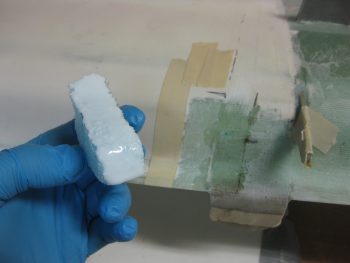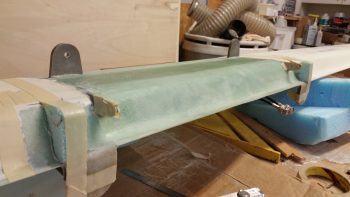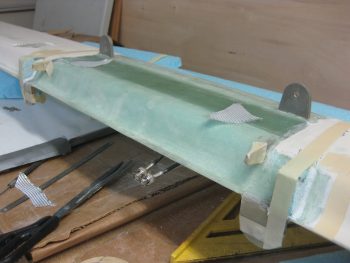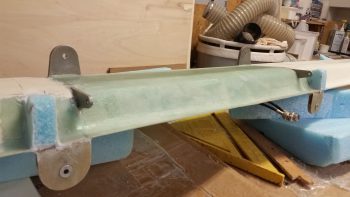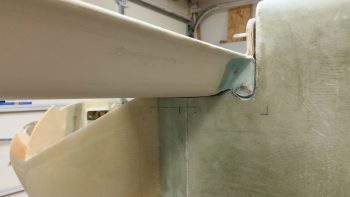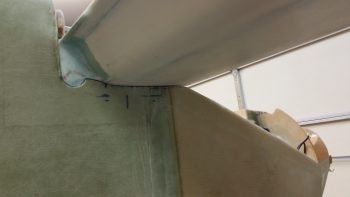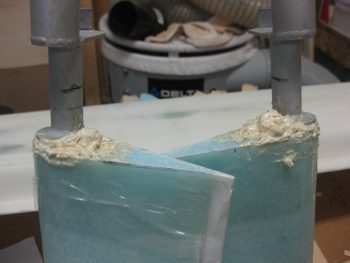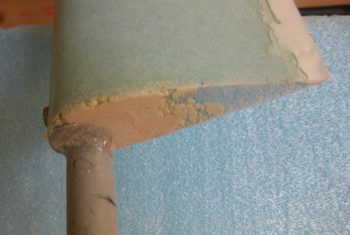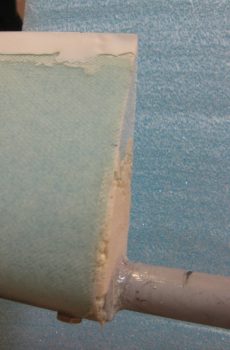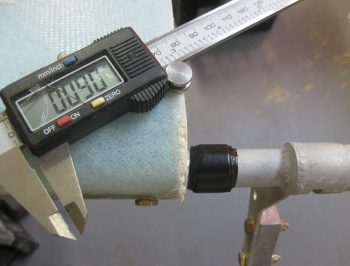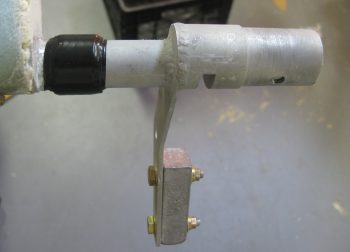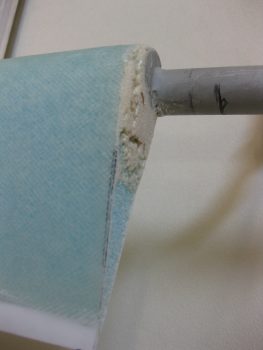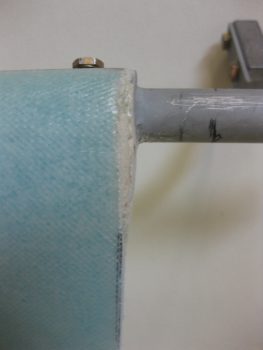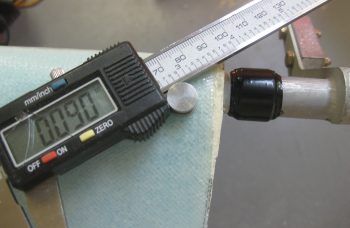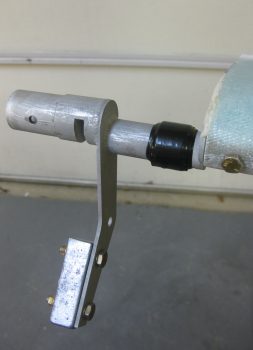Chapter 11 – Elevators
3 May 2013 — Today I started building the elevators. Not because I simply got bored with the canard, but there are foam hard mounts that get inserted into the blue canard foam near the trailing edge before it gets glassed. These foam hard points hold the elevator hinge brackets (with a little help from a lot of flox) into the underside of the canard, allowing the elevator torque tubes to pivot around the hinge brackets . . . which are spaced at various points along the canard, matching up of course to the hinge insert slots that I riveted into the elevator torque tubes.
I started off the elevator build by assembling the elevator torque tubes. I inserted the torque tube hinge inserts (NC-2) into the elevator torque tubes, drilled the holes, chamfered the holes, and then riveted the hinge inserts into the torque tubes.
[NOTE: I’m using the Cozy Girrrl’s Torque Tube Offsets, which were developed for the Cozy. These offsets allows the side hole in the fuselage walls to be made with a much tighter tolerance (read: smaller) and therefore less undesirable air (read: cold!) makes it through the elevator fuselage slots/holes. The result of all this is that I only require 4 each hinge inserts (NC-2) vs the 5 required for a stock Long-EZ build.]
I then pulled out the foam elevator cores. The actual elevator cores didn’t come out quite so easily, so there was a lot of razor cutting (and admittedly cussing…) and a fair amount of work to extricate the cores from the foam block.
I cleaned up the foam elevator cores & test fitted the elevator torque tubes into the round opening at the front of the foam cores.
I then installed the triangular hinge jigs (NC-7) into the hinge inserts & held them in place with the stainless steel hinge pins. I started with the Right torque tube & inserted it into the Right elevator core with micro to secure it in place. Since I only had 2 hinge jigs (NC-7), I let the Right elevator assembly cure before moving onto the Left torque tube (in pictures #2-4 of the Left torque tube below it appears that the foam elevator core is attached to the torque tube, but they were only mocked up before I actually micro’d them together AFTER the Right elevator torque tube and foam core were bonded together).
As the Left elevator core was curing to the torque tube, I went to my downstairs shop and cut the 2-plies of UNI at ± 30° for the Right elevator.
I attached the Right torque tube/foam elevator assembly bottom side up to the work bench using 5-min glue, while the Left elevator torque tube/foam core assembly micro bond was curing.
I then microslurried the foam on the Right elevator bottom-side and glassed the 2-ply UNI layup, alternating the orientation by 30° for the 2 plies.
•••
4 May 2013 — I 5-min glued the Left elevator upside down to the workbench in preparation for glassing.
I then cut 3 sets of elevator glass: 1 set for the Left elevator bottom side, and 2 sets for the top sides of the elevators.
•••
5 May 2013 — The Right elevator seemed to be curing a little bit slower than normal, so I had thrown a heater on it and that seemed to do the trick. I pried it off the table, hit the front round edge of the glass with a hard sanding block to prep a transition for the topside glass layup that would overlap onto the bottom glass for glass-to-glass continuity.
I then removed about 0.4 inches of TE foam & sanded down the newly visible glass for glass-to-glass continuity at the TE as well. I then bondo’d the Right elevator right-side up to the workbench.
With both elevators now affixed to the workbench, I proceeded to layup the top side of the Right elevator & the bottom of the Left elevator.
I peel plied the LE of the Right elevator, and after the epoxy had cured a bit & the glass was still tacky, I micro’d in the channel on the TE of the Right elevator & covered it with peel ply.
•••
6 May 2013 — Early this morning I razor cut the edges of both the Left & Right elevators. I used my long carpenter’s level and it work well.
I left the Right elevator bondo’d to the table to ensure it cure thoroughly & straight. I set up a quick makeshift heat tent over it using the same stuff that I got from Praktiker to post cure the fuselage and fired up a heater to post cure it in its straight & true state.
I removed the Left elevator from the workbench. Unfortunately, some micro had seeped under the Inboard edge and tore a chunk of the elevator foam out. I carefully removed the chunk of foam from the table, then set it aside with the elevator. I then removed all the remaining blobs of 5-min glue & small bits of foam (that typically come off a foam surface when it’s 5-min glued down) to finish prepping for the Left side elevator’s final layup.
I sanded the Left elevator LE & used the Dremel tool to remove ~0.4″ of foam & dead micro from the TE.
I then bondo’d the Left elevator down to the workbench right-side up.
I then cleaned up & micro’d the extracted piece back into place.
I then glassed the top side of the Left elevator, peel plied the LE, and then dry micro’d & peel plied the TE.
I trimmed the overhanging glass back within 1/4 inch.
•••
8 May 2013 — Today I slowly pulled the elevators off the workbench & checked for straightness, etc. They both looked good . . . besides the fact they look like they have chicken-pox from the bondo blobs.
Of course I couldn’t resist seeing how the elevator would look once it was mounted, so I held it up in place and snapped a couple of pics:
•••
12 May 2013 — I started today by “razor” trimming the elevator edges using the Fein saw. In doing so, I ensured that the Outboard edges & ends were square.
I removed the glass that had been laid up over the NC2 hinge slots.
I then cut some peel-n-stick sandpaper into approx 5/8″ strips and stuck them to the edge of one of the aluminum straight “boards”.
I sanded the elevators’ TE with the new sanding board, and then sanded the LE glass overlap.
I cut the foam at the Outboard ends around the edge of the glass to prep for flox corners. I made up some flox, for the edge channel, then I micro’d what small area was left on the ends of the elevators.
I glassed a 1-ply layup on the Outboard end of each elevator. Then I took a break and went to see a movie.
When I returned from the movie, I knife trimmed around the edges of the elevator end layups.
I snapped a few pictures of the canard with the elevators as well.
•••
13 May 2013 — Today I started by installing the elevator tube end inserts (NC-6) into the Outboard end of the elevators.
I lined up the stainless steel hinge pin, then marked & drilled a #10 hole for the setscrew. After the setscrew was in, I insured the NC-6 was even with the Outboard edge of the elevator tube & then drilled a #30 hole to set a PPC-42 Cherry Pop Rivet.
In the picture below the stainless steel hinge pins are shown to Left of the elevators.
I gathered up all my NC-3 elevator hinges, 3 for each elevator.
I then installed the SS hinge pin starting on the Outboard side of each elevator at the NC-6 tube end insert . . . then through the two hinge inserts (NC-2) and ending up at the Inboard side of the elevator. [Note: Again, I’m installing the Cozy Girrrl’s elevator torque offsets (shown below), thus there are different amounts of elevator hardware required than spelled out in the Roncz Canard plans.]
These pics show the Cozy Girrrl’s Elevator Torque Offsets. These have the smaller offset tube towards the middle of the assembly which provides a more concentric movement, and thus less removal of fuselage sidewall material is required for elevator travel (as compared to the stock plans configuration) as this assembly pivots when the elevator controls are moved. Obviously significantly less material removed and not having to have a decent-sized slot on each side of the fuselage greatly mitigates the amount of air (usually reported as “cold”) that sneaks into the cockpit.
Now back to inserting the hinge pin . . . note the hinge pin hole in the torque offset that I’m holding in my hand in the pic above right.
So, the hinge pin insertion exercise went fine on the Right elevator . . . However, the Left elevator decided to be a PITA & not be so cooperative. It was as if some invisible force was blocking the hinge pin from going through the first hinge insert (NC-2). I tried everything I could think of . . . then I realized something was blocking it, the bottom of the hinge insert trough that the hinge (NC-3) was supposed to slide into. It wasn’t a clearance issue laterally left-to-right with the hinge pin, it was an up-n-down issue with the hinge not having clearance at the bottom of the hinge insert to be inserted far enough.
After messing around with it for another 1/2-hour or so, I grabbed my square file and filed the bottom of the NC-2 hinge insert trough. Slowly but surely, that did the trick. I’m not sure how or why this happened, but I needed to file down about 0.05″ to get the hinge “top” to freely pivot in the hinge slot.
Once I got that issue out of the way, I mocked up the hinges to their dense foam mounts on the canard.
In the pic below the Inboard hinge/torque offset looks drastically off from its associated dense foam mounting point on the canard. The reason why is that the torque offset actually gets mounted much farther Outboard (in relation to the elevator itself, not the canard) than what I have mocked up in the pic. There’s quite a few inches of the Inboard elevator tube–along with some glass & foam as well–that gets removed to make this happen.
•••
14 May 2013 — I started today but doing some quick checks on the elevators to make sure I hadn’t screwed something up along the way . . . not that I’ve made a mistake yet, but there’s always a first time for everything! (He said facetiously).
I checked both elevators with the NC-7 jigs & they lined up exactly like they were supposed to. It’s definitely an internal clearance issue between the NC-3 hinge edges and the bottom surface of the hinge insert (NC-2) slot.
I used the Dremel tool to carefully make the hinge slots wider (this is per plans, not an attempted remedy for the clearance issue above) by removing some of the tube siding at the end of each side of the NC-2 hinge slots. I measured the hinge pin-to-LE on all the hinge assemblies and all were right at 0.49″-0.5″.
Finally, I double-checked the top contour on the elevators using Template H, not surprisingly call the Elevator Top Contour Checking Template. (Note: You can see the result of the foam overlap onto the elevator tube having crumbled and broken off when I mounted the tube into the elevator foam with micro. The channel for the aluminum elevator tube just wasn’t large enough, and the result was that most of the thin foam came off in the process. This left a small depression where the foam should have gradually overlapped onto the tube. This depression will of course be filled in with micro during the finishing stage).
•••
16 June 2013 — First, I started off today by dismantling the canard jig (notice both elevators in pic below).
I then sanded the Left & Right elevators, cleaned them up, vacuumed up the dust and took them down to the basement in preparation for getting packed up, shipped off and stored for a year.
•••
8 October 2015 — Today I started work on the Left elevator to get it ready for finishing. I double checked the width of the elevator and ended up sanding the trailing edge to get it to a uniform width along the whole length of the elevator. The outboard width of the elevator was 4.578″ inches wide while the inboard was 4.624″ wide. After some very minor sanding, focusing on the inner 2/3rds of the elevator, I got the very inboard edge right at 4.6″. With just a tad bit more sanding, while ensuring my TE was straight, I ended up with the inboard edge at right about 4.597″ …. less than 20 thou along that span is golden for me. Any more sanding was just asking for a “chasing of the numbers” with the result being an elevator that’s too narrow.
I then started sanding then entire front nose area & top of the elevator. Since I got the elevator foam cores from Feather Light, and since Feather Light uses the original Roncz elevator templates, a decent amount of foam along the razor-thin top front edge of the “C” shaped cutout (where the elevator tube is embedded) was broken off or torn away when I micro’d the foam to the elevator tube. I think this is fairly common since using the original template results in that “C” channel just being ever so slightly too narrow for the elevator tube to fit into. In other words, besides either cutting them myself and slightly modifying the channel before hot-wiring the foam, or using Steve’s Eureka CNC elevator cores, the bottom line is that minor carnage on each leading edge of the “C” channel was bound to ensue as the elevator foam is micro’d to the elevator tube.
Why am detailing all of this? Because after glassing the elevator skins, there remains a very slight depression (trough, if you will) along the length of my elevator right at the top junction between elevator tube and foam core. In the picture below, it is the line that is even with the top of the elevator hinge slot, and again, runs the full length of the elevator along the “nose”. Also note in the pic below that the area to the left of the elevator hinge slot is sanded while the area to the right is not.
•••
12 October 2015 — I started off today by hitting the cured micro on the elevators with my 36-grit sanding board. After I got the edges somewhat feathered out & the ridges removed, I switched to a piece of 36-grit sandpaper that I simply wrapped around the curve of the front part of the elevators. I then finished up with a few quick passes with 80 grit. Below is a pic showing the comparison of a sanded elevator (top) to the other one still needing sanding.
Below is a shot of both elevators’ sanded top leading edge micro strips.
After sanding the front sides of the elevators, I checked the TE of the Right elevator. Actually, I was checking the width front to back along the entire span of the elevator just I had done with the Left elevator. Each end of the elevator was a tad thicker at just over 4.6″ wide, while the center of the elevator was 4.583″ wide. I sanded the elevator on the 80 grit sandpaper I have mounted on the edge of my long aluminum straight board that I bought over in Germany (yes, still thinking these things are awesome!). After a few minutes of some very careful sanding, I had the ends narrowed to 4.589″ on one end and 4.587″ on the other end. I figured I would stop while I was close and not muck it up by going too far. Now both my elevator widths are confirmed in specs.
After sanding the elevators, I took a break from sanding to Alodine the elevator spool tube. Although I would have preferred to wait until I cut this spool tube to length before Alodining it, the weather here in northern Virginia is getting cooler by the day. So, while it was an absolutely warm gorgeous day I figured I would Alodine the tube and get it out of the way.
I had some 1-1/2″ PVC on hand, so the other day I bought two end caps. I cut the PVC into two 24″ lengths, wrapped an end on each tube with some sealant tape and secured the end caps. I then deburred one end of the spool tube, gave it a quick wipe down with acetone, and then cleaned it thoroughly with Simple Green.
I grabbed the tube, along my Alodine & Alumaprep, some thick rubber gloves, the rest of my gear and headed to the back yard. I will tell you that although I’ve stored my chemicals in a cool dark place it’s very noticeable that my Alodine & Alumaprep are really getting stale. Instead of the stated 2 minute soak time (personally, I’ve seen 3-4 min ranges) in the Alumaprep & Alodine, it took almost 10 minutes each to get a decent clean & color on this spool tube. No worries, I guess the stuff is still doing it’s job, it just takes a little longer. Kind of like me as I get a little older! Ha!
Since about 5-6″ of one end of the spool tube will be getting cut off, I used this end to handle the tube & tie string to for dunking it into the solutions, and for suspending the tube as it dried.
I pulled out the “L” templates for mounting the elevators to the canard.
A shot of the “L” templates mocked up in place.
And a shot of the Alodined spool tube. [NOTE: As a reminder, this spool tube is not per Long-EZ plans. This is a cross tube used between the elevator offsets in the Cozy. These offsets are manufactured by the Cozy Girrrls and provide two distinct advantages over the plans Long-EZ offsets: 1) The big advantage is that the configuration of these offsets is one that requires a much, much smaller hole in the sides of the fuselage to manipulate the elevators. 2) With an offset on each side of the fuselage (versus just the right side on the Long-EZ) there are more options to mount direct drive control arms such as pitch trim, autopilot servos, etc. Lastly, although not necessarily an advantage, I do like that the entire elevator configuration is symmetrical.]
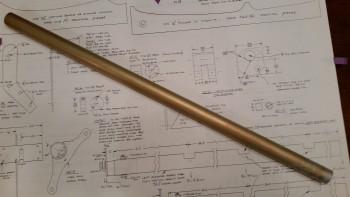
With the bottom surface of the canard now finished to the primer, I don’t want to bondo anything (i.e. “L” templates) to the surface of the canard just to have to clean it up later & risk messing up the finish. For this reason, ala my friend Dave Berenholtz, I will simply keep the “L” templates in place by weighing them down.
So as I was out & about tonight I stopped off and got the materials & supplies required to make some sandbags. When I get those made tomorrow I’ll start on the journey of installing the elevators to the canard!
•••
13 October 2015 — After attending a work meeting this morning, I started out today by spending a couple of hours finalizing my plan for installing the elevators on the canard after reviewing the Long-EZ plans, the Roncz canard plans, the Cozy elevator install plans, and my notes.
The first task I needed to complete was to mount the two CZNC-12A Torque Tube Offsets to the each end of the Spool Tube. Of course, to do this I had to know exactly how long the Spool Tube needed to be. I spent a good hour and a half mocking up the Torque Tube Offsets, the Spool Tube, and canard dimensions. I really needed to lock down the dimensions of the fuselage in the F22 & F28 area to ensure that the elevators are mounted correctly.
After essentially transcribing the outline of the fuselage onto the canard surface, I checked and double checked the dimensions a few times over. After confirming the numbers, I came up with a spool tube width of 17.6″. This is 0.9″ less than I had originally estimated when I worked up the numbers in Germany back in 2013.
Before I started cutting anything I checked a couple more details in the plans & online. I also gave Chrissi from the Cozy Girrrls a call to verify some of my install steps. After chatting with Chrissi for about an hour on the elevators install (and a few other things), I was ready to pull the trigger.
I measured the spool tube & marked it with a piece of paper to ensure I would have a square cut (pic below). I then cut the spool tube on the chop saw just a hair off the line (middle pic). I then removed the paper and cleaned up the cut with sandpaper (bottom pic).
Now, in real time I showed the pics above out of order. To cut the spool tube I needed to get the 50-pound bag of play sand off my cutting table. So, I simply made up six 5-pound sandbags. I took the leftover sand and dumped it into one of the sandbags I bought along with the bag of sand (the sandbags are the white plastic bags under the sand).
The sandbags I made are shown below placed over each “L” template.
Back on the spool tube: I mocked it up with the torque tube offsets in place & ensured it matched the marks I made up earlier (it did).
I set up a table to mount the torque tube actuators to the spool tube. I clamped the whole assembly down to the table after ensuring it was all aligned. To help ensure that all the pieces stayed aligned, I installed the 3/16″ stainless steel hinge pin all the way through from one end to the other.
Below are a couple of shots after I drilled the two holes for the AN3 mounting bolts.
And here’s a couple of shots with the bolts installed (after I deburred all the holes) and the torque tube offsets mounted to the spool tube.
I then spent about another hour making the 0.2″ (actually 0.23″) gap spacers and mocking up the elevators. Here’s a shot of the Left elevator with 3 gap spacers installed.
And here’s a couple of shots of the elevators loosely mocked up into place.
Next I’ll work on tweaking the elevators into their final positions, get the inboard ends of the elevators cut to length and mounted to the torque tube offsets. I’ll also be installing the stainless steel hinge pins and hinge tabs to allow for marking the hinge locations on the canard. In addition, I plan to cut the 6 slots for the hinge tabs into the bottom surface of the canard. Finally, if all goes according to plan, I’ll be floxing the hinge tabs into place.
•••
14 October 2015 — I started off today by nailing down the required length of the elevators in order to get the spool tube & offset assembly mounted to the elevators. In the picture below, the torque offset at each end of the center spool tube assembly needs to be inserted into the inboard elevator tube, drilled and secured with an AN3 bolt on the respective elevators.
To get the two elevators and center spool tube assemble bolted together, I first needed to know what the required length for these individual pieces are when they’re attached as one. Obviously if it’s all too long then it won’t fit inside the swoosh tip end caps (and the hinge & hinge hard points won’t align), and clearly being too short in length causes problems as well.
I needed to keep account of the 1/16″ minimum clearance between the outboard elevator edge and the not yet glassed swoosh tips. The Cozy elevator plans say 0.1″ and I’ve also heard a 1/8″ gap bantered around as well. I started with 1/16″ inch, but then using a popsicle stick ended up with about a .083″ gap (or around 5/64″ of an inch). With the outboard elevator edges good, I moved inboard to figure out where I needed to cut the actual elevator, and its shape, and then where I would need to cut the actual elevator tube on each side to ensure all these dimensions would synch up.
I’d like to point out, for those that may still be slightly confused as to what I’m doing here with this whole “Spool Tube Assembly” thing that the Long-EZ clearly doesn’t have per plans. The pic above is perfect for showing the “old” Long-EZ way of installing the elevators, with the longer left elevator tube crossing the fuselage and then both torque offsets getting mounted together within an inch or so of each other on the right side of the fuselage. Sitting atop the canard in the above pic is the “new” way, or simply installing torque offsets from the Cozy. Since the Cozy has a control stick on the fuselage (cockpit) sidewall both left and right, then it stands to reason there’s a torque offset on each side of the fuselage to connect to the control stick linkage. The “spool tube” merely connects the two torque offsets, and thus the elevators, from one side to the other. Again, to explain WHY I’m dong this, I’ll quote the part description from the CG Products web site (In short, it turns the banana-shaped hole into a small round hole so you don’t freeze your tootsies off in flight!):
WHILE NOT A “PER PLANS” PART IN THE LONG-EZ, THESE PARTS SOLVE THE SERIOUS DRAFT PROBLEM IN THE LONG-EZ WHERE THE ECCENTRIC MOVING ELEVATOR TORQUE TUBES COME THROUGH THE FUSELAGE WALLS. THIS IS ACCOMPLISHED BY SHIFTING A PORTION OF THE MECHANISM TO BE CONCENTRIC WITH THE HINGE AXIS.
Once I got the outboard elevator ends figured out, I installed the hinges and marked the locations of the hinge slots on the canard on both sides.
I then removed the elevator, removed the hinges so as not to cut the 3/16″ stainless steel hinge pin by accident. I transposed the marking on the bottom of the elevator to the top, and checked the accuracy of my marks by drilling a 1/16″ hole straight through the elevator from the bottom to the top . . . right on the line each side!
I then used the Fein saw to cut through the elevator skin & foam.
Here’s the final product:
After trimming the inboard elevator on the other side, I marked up the actual aluminum tube to be trimmed down.
I ended up cutting one elevator tube with the chop saw, and the other side–in trying to conserve more of the elevator’s inboard edge shape–with the Dremel tool, then sanded it to length.
Here are the elevators, each cut to length, mocked up & temporarily attached to center spool tube assembly. I double checked all the lengths & dimensions, and it all looked good.
A long view . . .
I then hunted around for a decent sized board–moreover, one that was straight!– to cut for the jig mounting bases for the elevators to sit on while they are bolted to the torque offsets on the end of the center spool tube. I cut a pine board I had into 6″ lengths and then screwed them to the work bench, all with a 1″ overhang.
I then checked the entire length for straight & level with my German aluminum straight board. My second and third jig was a little low, so after hunting around a bit for something to fill the gap, I got the idea to recycle a piece of 80-grit PSA sandpaper (sticky backed) to use on the second jig, and on the third jig a piece of 36 grit. Those did the trick and the mounting jigs were all straight and level!
I then mounted the elevators to the center spool tube assembly & torque offsets. Since there is a hinge that goes into each torque offset assembly, then the 3/16″ stainless steel hinge pin goes all the way into the torque offset. This really makes it easy to figure out the angle of torque offset arms because the hinge pin must be installed. In other words, if I’m off, it won’t be by much at all!
I marked up a popsicle stick with a line at 1.6″ to set the distance between the back edge of each jig to the TE of the elevators. As I measured each TE gap on the jigs, I weighed down the elevator at that jig. I then installed the 3/16″ stainless steel hinge pin into each side [NOTE: If I had been thinking more proactively, at this point I would have installed the hinges to avoid having to install them later and thus keep from having to manipulate the entire assembly as one complete unit].
Pardon the fuzzy pic below, but if you look closely at the root of each elevator you’ll see that I’ve drilled the #12 hole on each side.
Here’s a shot of each side of both the inboard foam edge of the elevator, and the screw I placed right behind the trailing edge of each elevator to keep the elevator from shifting away from the drill bit as I drilled the holes.
And here’s pretty much the same views only this time the bolt holding the elevator to the torque tube end is visible inside the foam.
The next step was to get the elevator hinge slots marked up for cutting.
I then cut the slots for the hinges and dug out the foam down to the top side glass.
After vacuuming out the hinge slots in the foam hard points embedded inside the canard, I pulled off the sandbags.
I then installed all 6 hinges with their associated washers.
I then reset the “L” brackets, secured them in place with sandbags, and remounted the elevator-spool tube-torque tube assembly to the canard. I slid the hinges into the hinge slots to check their fit, which will definitely need some tweaking.
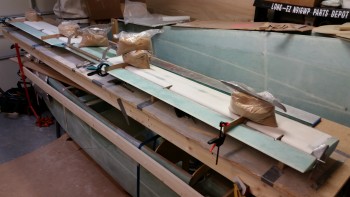
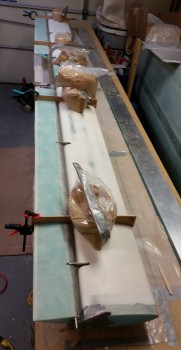 Next I’ll be working–probably all day long–to get the elevators situated correctly on the canard and then the hinges floxed into place inside the hinge slots.
Next I’ll be working–probably all day long–to get the elevators situated correctly on the canard and then the hinges floxed into place inside the hinge slots.
•••
15 October 2015 — There are a number of major tasks in building a Long-EZ that remind me of that aged old question: “How do you eat an elephant?” And of course the answer is: “One bite at a time!” Ahhh, true words in the realm of airplane building. Thus it is so with mounting the elevators onto the canard.
My first task today was to review the plans and my notes. I then went out to the garage and assessed how the elevators were looking in their mocked-upped state on the canard. It was immediately clear to me that the bottom edge of each of the elevator hinge bracket slots would have to be lowered. These are the slots that I cut into the foam hard points on the canard last night.
After dropping the aft edge of each hinge slot, ensuring that I had a glass surface in the bottom of each slot, cleaning up the foam bits, and vacuuming the holes out, I remounted the elevator assembly to take a look. Ah, much better! The elevators were aligning much better and the gap between the elevators and the canard looked good, at least initially. I stole a page from my good friend Dave Berenholtz’s build book by using shims to lock the hinges in place so I was free to play with the elevator movement and really get a good idea of my elevator travel situation.
I checked the alignment between the two elevators to see if I had any issues. Sighting down the TE of the elevators I was quite pleased that it looked like the TE was on rails as far as the alignment between the left & right elevator. I tried to get a shot of it as best I could, thus the 2 pics below:
Before I went any further I gave Mike at Feather Light a call about the Canard TE and the interface gap between the canard and elevators. Since Feather Light cut my canard & elevator cores, I wanted to discuss my slightly high TE as compared to the template in the Roncz canard plans. My TE is just angled slightly less downward as it slopes aft, which makes the ENTIRE TE measure about 0.07″ higher than the diagram in the Roncz canard plans. Since the fishtail on any aerodynamic surface is glassed first, this wouldn’t be an issue of my doing since I merely glassed the bottom of the canard first, which included the already shaped TE fishtail. After a good talk with Mike I felt comfortable in keeping my gap wedges at 0.23″ thick, since this would: A) put the bottom of the elevators ever so slightly toward their original position as per plans, and more importantly B) still give me an appropriate gap, especially once the finish and paint is complete. So, I pulled the trigger & moved on!
I then mounted the elevator angle template to see how I was doing on the elevator travel angles. Of course the long pole in the tent when mounting the elevators is to ensure there’s enough up-elevator travel… otherwise known as the “ever-elusive 15° up travel,” or something clever like that!
As you can see from the pics below I was getting somewhere around a 13.5°± up travel. Of course this is already within specs as 12.5° up travel is the bare minimum, but since I was just starting out, I figured I could easily squeeze another degree from somewhere & get this thing close to 15°!
And to be clear, getting the max 15° travel really isn’t a pride issue. I’m seriously just trying to be proactive since once the finish & paint go on, as well as the 2 plies of UNI for the outboard elevator weight, who knows how much that will reduce my up elevator travel. So I want all I can get from the start.
I found the culprit at the very inboard edge of the right elevator. I locked the elevators in the up position by placing a sandbag on the torque offset arm (you can see it in the pic below) and then started sanding away with some 36 grit.
After a bit of sanding I tried the up travel again and only saw a slight improvement. So I checked the gaps and position of the elevator assemblies, and then pinpointed the exact spot that was causing the issue. I took a Sharpie and marked the offending area and hit it with another round of 36 grit, as you can see in the right pic below.
I figured while I had the elevator locked in the “up” position (of course it’s really in the down position) I would grab a couple shots.
Clearly I have no issue with my down elevator travel!
And now I’m good on my up elevator travel! I always say that there’s no problem in this world that can’t be fixed with 36-grit sandpaper . . . ha!
I moved the elevator degree template over to the other side and am still getting about 14.7° up travel. Not sure why the difference since I rechecked my gaps, my “L” template spacings, and left/right elevator TE alignment. Could just be a combination of factors, but since everything else is lining up well, I’m calling this good.
A thought I had on the inboard problem area causing the limit in up elevator travel is that if I go with a decent fairing at the elevator root then I could simply eliminate the problem area. I’ll keep that in my back pocket in case I need it later on.
Here I’m simply comparing the “Zero” elevator in trail on the degree template vs. the zero trail on the “L” template. I already knew there was a very slight gap on the “L” templates towards the TE of the elevators when I checked them against the Roncz canard plans diagrams, but I was curious how these matched up. They’re only slightly different, but close enough to get the kinks worked out when I rig the elevator control system later on.
And here’s a wide-angle shot of the elevators in the up position.
I spent about 45 minutes checking the elevators and spool tube assembly for alignment. I took out my über gut German aluminum straight board to check the TE alignment. My right elevator was just a tad off with the inboard more aft than the outboard end. When I checked my “L” template alignments, I realized that perhaps working the elevator up & down had caused the right inboard hinge point to be off. So I went back and rechecked every gap spacer and “L” template for elevator vs canard spacing, and then did a TE check again. I checked my elevator travel again and it all looked great.
I stole yet another play out of Dave Berenholtz’s playbook and instead of floxing all the hinges at the same time, I wanted to ensure that I install the elevators in one calculated step at a time. Thus, I taped the areas around each of the two middle hinges of the left and right elevators, respectively as you can see below. This gives me a midpoint fulcrum, if you will, to ensure that the the outboard and inboard hinge areas are perfectly set when I flox them into place.
Also, I noticed that the gap between elevator and canard TE in the middle of each elevator is about 30 thou greater than each end of the elevator. After looking at this for a bit, I concluded that it’s most likely hot wire drag when they cut the foam cores. I point this out because I also noticed that if I just added the slightest bit of pressure on top of the elevator (as it sits now) that the gap almost completely closes. I then tried adding a little weight to the midpoint areas of each elevator and sighting the TE from end to end: no discernible negative affect on TE alignment. Thus, in each pic below you’ll note that there’s a sandbag next to each middle hinge point as the hinge is getting floxed into the slots on the canard. And again, we’re talking maybe a total movement of 15-20 thou when all is said and done, so I don’t see the hinge swing geometry getting all wonky either.
Fast forward 5 hours later and here are the two midpoint elevator hinges mounted in the canard, after I cleaned them up.
The next step will be to finalize the floxing in of the elevator hinges into the canard hinge slots.
•••
16 October 2015 — First thing this morning I checked the elevator up travel to ensure that my floxing in the middle hinge on each side didn’t gum up my good numbers thus far. The right elevator was now sitting right at 15° . . .
. . . while the left elevator was just a hair over 15°. So the pattern continues that the left elevator is seeing about a .5 to maybe 1° higher swing than the right. However, this could be the contour of the canard top where I have the “G” template mounted, or something else entirely. The bottom line is that the elevators are matched, travel in unison, and the most limiting point in up travel allows a full 15° up, so I’m happy.
Below is a wide-angle shot after I taped up the other 4 hinge slots in prep for flox.
And here’s the busier mid-canard area with the two hinges that connect the respective torque offsets to the elevators and spool tube — taped and ready for flox.
I realized that I hadn’t yet taken a good (or passible in this case) shot of the bolts attaching the elevators to the torque offsets from the front side of the elevator. Here you can make out the bolt heads at the root of each elevator at each side of the pic.
Next, I floxed in 3 more hinge tabs. The left Inboard hinge needed just a slight bit of coercive pressure to get it to line up correctly (we’re talking around 20 thou in movement), so I decided to get it set, leave it alone, and work on the other 3 hinges to limit my variables on this round of floxing.
While the 3 floxed hinges were curing I started on some prep for the upcoming steps. First, I gathered up my outboard elevator weight positioning jig (“J” template), sanded the very rough edges smooth and ensured they matched the Roncz canard plans.
Thinking I was finished with the H100 6 lb foam after I build the canard, I sent it off to an EZ building buddy of mine before realizing this past week that I needed it to attach the outboard elevator weights. Doh! So I ordered some more from ACS a couple of days ago and it arrived today.
In addition, I traced out the Top Canard Contour Template “E” onto one of the 2×3’s I used for cutting the blue foam swoosh tips and made the first half of the top canard contour sanding block.
Finally, when I was at Home Depot yesterday I looked at buying a 24″ long piece of 4″ PVC pipe to sand the swoosh tip foam. They wanted $8 for it and I wasn’t in the mood to spend that much on a one time use thing, so I simply recycled my 2″ OD PVC pipe that I used to Alodine the Spool Tube. I attached a piece of 36 grit PSA sandpaper to it and plastic wrapped to allow the paper to fully stick to the PVC tube.
After a few hours of flox cure-time for the 3 hinges, I double checked the positioning and alignment of the elevators, pulled off the protective tape and cleaned up the dead flox goobers around the hinges.
Last hinge… I double checked all the elevators’ positioning and alignment again, and everything looked great. Since my prep tasks for the immediate upcoming steps were complete, and after floxing the last hinge into place all there was really left to do was let the hinge flox cure completely, I called my buddy Rob and made plans to meet for dinner, have a few beers and watch a movie. I did one final alignment check and then whipped up some flox, using fast hardener like I had done for the other 5 hinges. After I finished floxing in the last hinge (the left inboard hinge that attaches to the torque offset) I cleaned up the work area and then took the pic below. I was just getting ready to turn out the lights and leave the shop when I decide to do one more check on the hinge.
And boy I’m glad I did!
Since I moved the inboard hinges in about .2″ to .3″ from where I originally had planned for them to be installed, I was closer to the edge of the dense foam hard points that I installed before skinning the canard. Being closer to the inboard edge of the hard point, I gouged an area out into the blue foam to make a small pocket of flox to increase the mass and strength of the hard point to make up for being so off-center in the dense foam insert.
Well, with the right side inboard hinge there was no issue. But on the left side, the only hinge I did this with, I started off by filling up the hinge slot with wet flox right up to the lower line of the hinge slot opening in the canard. I then added some some more duct tape to make a tape “dam” about a 1/4″ higher than the bottom of the hinge slot bottom edge. I then thickened the flox just a tad and then poured it in, filling up the rest of the hinge slot.
Due to my using fast hardener, at some point the extra mass of epoxy in that blue foam pocket, or perhaps there was an air bubble, or whatever it was . . . resulted in the a volcanic eruption of the flox back out of the hinge slot! This occurred as I was cleaning up and I had no idea that it had happened. There was enough flox that came out of that hinge slot (think baby spitting up!) that it enveloped the gap between the spool tube & canard, the connecting bolt & canard, and even some of the actual hinge & canard. If I had walked out without cleaning that up I would have had an absolute catastrophe on my hands upon returning a few hours later!
At first I thought it was merely an air pocket that had burped for some weird reason, but as I was scooping all the flox back into place, I could feel that there was definitely some heat being generated. Somewhere in the bowels of my hinge slot there was a exotherm event taking place. I quickly grabbed my IR thermometer and checked the surface temp around the hinge slot. The hottest reading I could find was just over 120° F, so I doubt if any foam damage occurred since at the moment it happened, while my back was turned, it puked out at least 50% of the flox that was in the hole and certainly allowed for a lot of heat to vent out at that point. Moreover, the timeframe between it being good to then going spastic, to me scooping up flox puke was 2 minutes at most.
After getting the majority of the flox back into the hinge slot, I went upstairs to grab a very quick shower and change. When I came back down to the shop less than 10 minutes later I was getting a temp reading around 88° and no more signs of disruption. I cleaned up a little more around the hinge and took off.
When I returned, all still looked good and no issues. It definitely made for an exciting time on that final hinge floxing. I looked all around the hinge area & underneath on the top of the canard for any discoloration or burn marks from the heat but thankfully couldn’t find any. Thus, I’m closing the case of the volcanic hinge slot.
Once the hinges are fully cured I’ll double check the elevator alignment, gap and travel to ensure it’s all still good.
•••
17 October 2015 — I started today off by checking the elevator travel to ensure it had maintained the 15° up travel that I had before floxing the remaining 4 hinges. I’m happy to report that not only am I still getting the 15° elevator up travel, but it’s better than when I started installing the elevators. Success!
I then double checked the TE of the elevators to ensure that they are even across the entire span of both elevators. They are… so success again! (It was difficult to get a full shot of this, but I tried).
To better show the TE alignment and to check the difference in elevation (this would be viewing the TE at eye level immediately behind it, looking that both left & right elevators align in the height and are straight across… versus above which is assessing the TE alignment from straight above) I ran a yellow string. It all looked good.
Here’s another shot of my “stringing” the elevators’ TE.
•••
18 October 2015 — Video showing the elevators in action:
•••
20 October 2015 — I turned my attention the elevator weights. But before I actually installed any weights I weighed them to better match them up for total weight on each side. All told there was a difference of 13 grams from one side to the other. The blue tags on each weight is the actual weight in grams of that lead piece.
I mocked up the right elevator to get all the parts synched up, and then started cutting the tough 6 lb. yellow foam.
I put tape over the jigs to keep them clean and also enable removal of the weight assembly once it’s floxed to the LE of the elevator.
I then prepped the elevator by giving it an extra good sanding in the area that will get the 2-ply strip of UNI holding on the outboard elevator weight.
Once all the prep was complete, I floxed the elevator weight in place (I surrendered my 5-minute glue here in Virginia when I moved to Germany and never seem to get around to picking up another bottle).
I then went back to work on the hinge pins. The right pin needed to be cut shorter since I had already made the notch for set screw and didn’t like the way that every time I moved the elevator in a distinct up or down fashion the flat tip flagged out past the canard tip glass into the airstream. I went back and looked at the plans again, and what I had looked pretty darn close to the diagram. However, to be fair the plans do say to keep the tip out of the airstream. So I simply cut it shorter & redrilled the 1/16″ hole more inboard.
Regardless, here are the two functional hinge pins. I still have to clean them up to beautify them, but besides their need for a surface makeover they work as designed.
•••
21 October 2015 — I started today by laying up the 11″ long 2-Ply strip of UNI around the outboard weight on the right elevator. I peel plied it and moved on to the other elevator.
Just as I did on the right side elevator, I shaped the 6# yellow foam and floxed the outboard elevator weight setup to the front of the left elevator.
While the flox was curing on the left-side outboard elevator weight assembly, I double-checked a few plans items and also drilled and mounted the right side INBOARD lead weight. I also predrilled the first hole on the left side INBOARD elevator weight as well.
By the time I finished some miscellaneous tasks, the flox on the left elevator outboard weight had cured enough where I could layup the 11″ long 2-Ply strip of UNI around the weight/foam arm.
If you look closely, the only real difference between the pics below is that the INBOARD elevator weight is mounted in the pic on the right.
A few hours later I mocked up the elevators and made the embedded notch in the canard on the left side to allow clearance for the outboard elevator weight.
And here’s the left elevator with attached outboard weight moving freely in/out of the notch on the canard.
Next, I’ll be finishing up the notch on the right side of the canard, glassing them and cleaning up the outboard elevator weight layups.
•••
22 October 2015 — I don’t have pictures of the real story here (yet), because it involves me using both hands to check the balance of the elevators. Going back to when I built my elevators in 2013, I had Bondo’d them down to the workbench as it says to do in the plans. Because the weather was still fairly cool in Germany and the elevators are small & fairly long, I decided to give them a good post cure on the bench to lock in their straight & true lines. I didn’t want them sitting in storage, as narrow as they are, warping into some weird position. Well, I guess I should have taken my chances on the latter.
You see, when I post-cured the elevators, apparently the Bondo holding them straight & true on the table was also cooking the foam on the other side of the glass skin immediately opposite of it. Thus, every single spot that I had a blob of Bondo became a localized skin delam. To fix the issue, I shot each delam with epoxy after having weighed the elevator first. Then I compared the weights, before and after, and also to the mandatory weight specs for the elevators (3.5 lbs left & 3.25 lbs right for stock elevators). The resulting weight for each elevator was right around 1.9 lbs, with less than an ounce gained from the epoxy injections per elevator.
The issue is that both my elevators both come in under weight, but after balancing them I realized that the right elevator–the one with the most delams–is not balancing properly, even after I mounted the inboard & outboard weights. After some really heavy sanding, I was able to get it to balance by adding about .07 lbs total, half to the existing weights on each side of the elevator.
However, to ensure that my slightly jacked up elevator is within specs, I’m actually finishing it to paint to ensure that it meets specs (I’ll be finishing the other elevator too). Pictures to follow soon. If it doesn’t meet specs, I’ll rebuild it. Even if I finish painting it and I have to rebuild, I’m sure I’ll have gained valuable insight into the finishing & painting process on the elevators . . . most likely the most sensitive item on this aircraft to be completed.
With the elevator balancing drama unfolding, I haven’t cut the outboard elevator weight notch in the canard on the right side yet. But I did lay up the 1-ply BID in the left side elevator weight “pocket.”
Since I had extra epoxy left over at one point–and hate wasting it–I finished shaping a piece of polyurethane foam into a mold for the elevator weight ice shield. The pics below are immediately after I popped it off the mold and set it on the canard to see how it fit.
Here’s the same ice shield after I trimmed it. I may change the shape later on, but it was a quick kill and for now I know that I have them done and ready for use.
I’ll keep working on the elevators and will start getting some pics so I can show you all what I’m working on.
•••
24 October 2015 — I will apologize right up front for not getting the requisite pictures that I promised of the elevators in their progressive state. I will attempt to tell the story better visually as it progresses. Right now I have the offending Right elevator with one Micro Skim coat applied to the underside of it and I will be sanding it down & applying either another Micro Skim coat or a pure epoxy wipe tomorrow.
In the mean time, to ensure I have everything I need to hot-wire another elevator, I traced the Roncz elevator templates off the plans onto a piece of paper.
Which resulted in this:
I had been to Home Depot earlier getting various items for the build, including a 2×4 to lengthen my hot-wire cutter. While there, I found these Formica samples in the cabinet aisle, so I snagged them. Not bad for free!
I then spray glued the elevator templates, after rough cutting them, to the Formica samples.
OK, I’m going to get on a huge soap box here! I have learned a ton from many who have gone before and completed these airplanes, but in general, there are many builders who are like birds in a nest squawking the same old tired songs. I read in the plans (the culprit) and then in a million and one places that Formica is the best for hot-wiring templates. Now, I admit I could have done something wrong in my application of employing Formica in creating my elevator templates, but the bottom line IMO is that Formica sucks!!!! It broke, shredded, snapped, crumbled, etc. as soon as my jig saw touched it. So, after getting ready to go back to the store to buy some stuff that ACTUALLY works!! I found an old license plate that would work. So, instead of using the worthless piece of crap Formica,I moved on to metal:
Ok, again, no pics here. But in the end it didn’t matter what I used. After messing around & testing my hot-wire saw, it’s just plain old & tired. I test drove it using the metal elevator templates I made, but it just didn’t have enough oomph to cleanly cut the foam. I thought I would at least try. So, instead of spending more money on getting new parts for the hot-wire saw, and more time, I’m punting and will simply order another elevator core (technically a pair) from Steve at Eureka CNC.
Finally, just thought I’d throw in a pic showing that I finished & trimmed the canard ice shields:
•••
5 November 2015 — As you can see by the pic below my new elevator cores arrived from Eureka CNC! Thanks Steve!
Next, I’ll be prepping for the building of the elevators.
•••
8 November 2015 — Today I cut the 8 pieces of UNI for the new elevators that I will be rebuilding here in the next week.
•••
26 January 2016 — Today I spent a good 45 minutes sanding the TE of the elevators to width to match the elevator templates.
Once I had the widths dialed in, it was time to mount them. Now, it seriously may just be my build (but from the reports I don’t think it is) but for those of you that haven’t inserted one of the stainless steel hinge pins into the elevator hinge channel, it is simply one of the most silly pain in the asses that I’ve ever dealt with… it is seriously a huge PITA!! I finally got so frustrated (and exhausted) trying to get the right hinge pin installed, that I pulled it out, took off the elevators & then tested the hinge pin separately in the canard mounted elevator hinge tabs, and then the elevator itself. Both seemed to work fine, but a little tight.
I took some 320 grit wet/dry sandpaper, hit it with a shot of WD-40 and “scrubbed” the entire hinge pin. I then tested the other side which actually needed some honing out on the NG6 hinge hole (with a 3/16″ drill bit), but I eventually got everything working smoothly. And I also treated the left hinge pin to a 320 grit rubdown as well.
I then reinstalled the hinge pins & remounted the elevators, which resulted in still a sheer amount of pain again, but at least this time they were moving . . . albeit ever so slowly!
Once the elevators were installed, I checked the gap between the bottom of the TE & the top of the elevator. The taped-together popsicle sticks I used to test the spacing were from the original set of spacers I used when I installed the original elevators. I double-checked the width of the spacer and it was right at 0.22″. I checked the fit of the spacer into the gap between the canard TE & the elevator on 3 spots each side: outboard, middle & inboard. Of all 6 spots, I got 3 spacings that were spot on (meaning 0.22″ gap), while the other 3 were just a tad tight (closer to 0.2″). So my spacings are looking great.
I then checked the up/down degree travel for each side of the elevator. For the up travel I got 15+° on each side.
And for the down travel I got well over 30° each side. So my elevator range of motion is phenomenal.
As for having any issues, I basically have 3 problem areas with the new set of elevators:
First, when I was trying to install the hinge pin on the left side, it felt like it was making it so I could barely pivot the elevator. Then it took less than a minute for me to realize that it wasn’t the hinge pin creating this friction, it was the left outboard elevator weight getting stuck in the channel. After further investigation I could see where it was pressed up against the forward side of the elevator weight notch in the canard. A little judicious sanding will clear that right up.
Next, (not shown) are the outboard TEs of the elevators vs the inboard TEs of the canard swoosh tips. The width of the elevator is not matching the associated TE of the swoosh tip, so this will have to be death with as well. To be clear, we’re talking less than a 0.1″ difference.
Lastly, but definitely the most serious of the issues (also not shown), is that the inboard third of the right elevator TE is about 0.07″ higher than its counterpart elevator TE on the left side. I measured this TE mismatch while the outboard TEs were matched at 0º elevation with the canard swoosh tip. I’ll have to figure this one out before I proceed.
All in all, for having to re-glass & remount the elevators, I’m really pleased with the quality & fit of the elevators on the canard.
•••
10 October 2016 — Today I set my sights on getting the elevators mounted to the canard with the canard mounted in place. I started with the right side elevator, first checking the stainless steel hinge pin alignment to see why it was so incredibly difficult to get the hinge pin reinserted when mounting the elevator to the canard. My investigation proved fruitful in that I reconfirmed that my NC2 hinge brackets are very closely aligned, with the center NC2 being maybe 0.050″ higher than the other two. The big issue was the hole in the canard swoosh tip. It was misaligned with the very first, outboard NC2 hinge bracket and was causing a fair amount of friction & discontent. Once I straightened out that outermost hinge pin hole in the canard swoosh tip, I really had a much easier time getting the elevator mounted.
I then set the canard with the right elevator attached onto the canard mounting “shelf” of the fuselage, but since the elevator offset actuator prevented the canard from seating onto the canard mounting shelf, I had to offset it so that the right lift tab was outboard of the right side fuselage (see pic below). Understandable of course since my exact goal here was to get the rounded notch created in the fuselage sidewall specifically for the portion of the torque tube offset that will traverse from outside fuselage to inside. This portion is the tube on the very upper left side of the pic below. Since it was a couple inches away from the fuselage, I used my straight edged ruler and estimated the perimeter of the half-moon depression I needed to make on the fuselage’s canard mounting “shelf”, while of course adding in the extra 0.1″ spacing around the traversing tube as per plans.
[You may have noted that my CS11 weight is mounted a bit askew. I’ll fix that later.]
I then moved the canard out of the way in prep of creating this small notch/depression in the fuselage sidewall. I would like to point out that if you had ever wondered why I didn’t notch my top forward fuselage area as it shows in the plans (below) –with a much larger circular notch for the stock elevator torque tube configuration– it’s because with the Cozy-style torque tube offsets I knew that not much more sidewall beyond the canard “shelf” would need to be removed, which is of course exactly the case here.
I then used my “Fein” saw, razor knife and a round Perma-a-grit tool to create the clearance required in the sidewall for the right torque tube offset.
I set the canard & elevator back in place to see that I had plenty of clearance.
The fit between the inboard edge of the elevator needed trimming for the elevator to travel full up (but not full down), so I trimmed ‘er up. As for the elevator-to-sidewall clearance spacing, the torque tube offsets are engineered so that the elevator torque tube attaches to the torque tube offset on the external side of the fuselage. Naturally, there is a bit more space required as compared to the original Long-EZ plans method of mounting the torque tube actuators internal to the fuselage. In short, this means dialing in a 1/16″ gap between fuselage and the inboard edge of the elevator is difficult at best. My estimation is that it will end up being around a 1/8″ to 5/32″ gap when the plane is finished and flying. No big deal, just a sideline affect of using the torque tube offsets.
In addition, the gap between the inboard edge of the elevator and the fuselage is really clearance measured when the elevator’s TE is at its uppermost position. As you can see, the lower the TE of the elevator goes, the gap between inboard elevator and fuselage sidewall naturally gets wider (at least it does on this bird).
After taking the same steps on checking out the hinge pin on the left elevator, I then repeated the process of creating a rounded notch for the elevator torque tube offset on the left side of the fuselage.
Here’s a money shot with both elevators attached to the mounted canard! A first for this bird!
Here’s the torque tube offset clearance on the left side.
Here’s a low angle shot that I took of the mounted elevators.
And a higher angle shot (excuse the mess, but there’s an airplane being built here! ha!)
And a shot of today’s work. Not much material removed at all (thankfully!) and I’m very pleased with how little fuselage sidewall had to be removed for the offset actuators to fit into place.
•••
11 October 2016 — I started out today by trimming the inside edges of each elevator to get the gap between the inboard elevator edge and the fuselage sidewall to about 0.1″. I had a discussion with my build buddy Marco earlier about these… specifically the fact that with the Cozy-style torque tube offsets, it really creates a bigger gap at the forward edge of the elevator where the elevator control tube bolts to the torque tube assembly flange. Marco suggested an inboard fairing, which I had already been mulling over. At one point I really liked how they looked, but after seeing the simplicity of the elevators against the sidewall, for some reason that really appeals to me. Moreover, “simplicity” is the key word here in that I don’t want to add another 4-8 hours on the build messing with inboard fairings. (Later in the evening I was emailing back & forth with my buddy Dave down in Australia …. he likes the fairings too! It’s a conspiracy against me, I tell ya! ha!)
Ok, so in the grand scheme of things my thought is that a 0.1 to 0.125″ gap is not going to bust the curb appeal of this bird. In fact, by the time the inboard ply of BID and a little micro goes on the fuselage side for finishing, I suspect it will be very close to 0.1″ max of a gap. So . . .
Set & match.
Done! And moving on!
(Sorry Marco & Dave … guess you guys will just have much more awesomer airplanes than me!)
Here’s the gap on the left side again. Note how it is wider as it gets closer to that torque tube offset flange near the control tube.
And the right side. Not as distinct of a gap near the torque tube offset flange.
Another view of the right side elevator gap.
Ok, first issue solved! (For now!). I then moved on with figuring out how to seal the gaping hole on aft side of the canard when mounted into the fuselage. Here I have Cozy-style torque tube offsets that operate concentrical & thus only require a round hole with a very small gap around the traversing tube (versus the SLOT that the stock elevator torque tubes require on the side of the fuselage), and yet immediately in front of it is still a huge open gap that must be filled in lest the cold air continue to spilleth into my craft.
I called Chrissy from the Cozy Girls since A) they make these parts, and B) they installed these parts on their Cozy. She confirmed my idea that you simply create a small piece of “fuselage wall” on the aft side of the canard so that when the canard is removed in somewhat normal fashion, then the “false” wall piece comes off with the canard. I asked this question of Dave B. down in OZ and he confirmed it with a simple diagram that is actually in the Cozy plans, that shows this small filler piece.
With a scant bit of knowledge in my brain, I trudged forward in order to defeat the evil dark forces that is COLD AIR spilling into the cockpit! I collected a bunch of 3/4″ pieces of Divinycell foam but then quickly realized that while these side walls do contain 3/4″ pieces of Divinycell foam, they are certainly not 3/4″ thick after a fair amount of glass laid up upon them (more like 0.87″). So, to get the right current thickness of the fuselage side wall and then also to save weight –since this is only really a plug to block air– I decided to use blue wing foam and cut/shape the starting block foam myself.
I started with the right side…
And first shaped the bottom angled portion and the aft vertical edge (aft is left in pic).
I then eyeballed it with some test fitting on the canard TE to take a good majority of the foam off the front side of it, where it mates to the canard TE.
Here’s the left side piece…
Initial fitting…
And more foam removed from the front side (of the left piece) in prep for final shaping.
I then finalized the shaping & fit of the canard aft filler pieces on the canard itself. With these about 70-80% good on shape, I then remounted the canard . . .
And finalized the shaping & fitting of the canard filler pieces. I’ll remove the circular area for the torque tube offset cross tube after I glass the filler pieces in place.
I then removed the canard and lightly Dremelled & sanded the finish off about 1″ outboard of each filler piece in prep for a 1-ply BID layup on each side of the respective filler pieces.
I then taped up the areas around the filler piece mounting locations for a little anti-gunk protection.
I then whipped up some micro and glued the pieces in place.
I taped the canard filler pieces in place and let them cure for a bit to allow them to better hold their position on the TE when I laid up a BID ply on each side.
As the micro was setting up I mixed up some pour foam and filled in the holes at the inboard end of each elevator (these are holes that I had to make to bolt the elevator tube to the outside torque tube offset connecting piece). I also filled in the gap at the top of the GIB seat & the CS spar (pour foam pics shown below).
A bit later I whipped up some more epoxy & flox. I created flox fillets in the corners of each filler piece & canard junction (pic below). I then laid up 1 ply of BID on each side of each filler piece overlapping from a 1/2″ to 1″ onto the canard TE (sorry, I didn’t get a pic of the actual layup).
Since the garage was about 68°, I set up heat lamps on the filler piece layups and let it cure for a while as I sanded the GIB seat back top in prep for glass (again, pics below).
Here’s how my canard filler pieces came out. They need a bit more tweaking on the fit & finish, but definitely not bad at all. I’m really happy with how they turned out!
Here’s a shot of the pour foam in the inboard ends of the elevators. Note the torque tube offset flanges that I discussed earlier… you can see them peaking out of the piles of foam.
•••
12 October 2016 — Today I focused my efforts on prepping the elevators for mounting them back onto the canard. I did a quick sanding & cleanup of the pout foam on the right inboard elevator edge.
I then wrapped 0.090″ of black electrical tape on the portion of the elevator torque tube offset that will travers the fuselage sidewall. The tape is for when I embed the torque tube offset FIRST into the bottom side of the canard filler piece. Then, when that cures, I’ll do the same thing on the fuselage side. These two new micro channels around the torque tube assembly will essentially act as a clamshell and close around the torque tube offset when the canard is mounted. And with only about a 0.090″ gap, it should definitely help keep the cold air out!
Again, I did a quick sanding & cleanup of the pout foam on the left inboard elevator edge.
And did the Cozy Girrrls’ tape trick on the left side as well.
[NOTE: Check out canard installation for the actual install of the canard with elevators attached… the lines are blurred during these steps as to what falls into what, so I placed the lion’s share of these posts in Chapter 12.]
•••

